"Puchero de Nadal" - Valencian Stew for Christmas
Friday, December 19, 2025
Although Christmas Eve is probably the most lavish meal of the Christmas holidays in Spain, originally it was Christmas day, much as it is in the UK. It was a day for bringing together the entire family including grandparents, uncles, aunts and cousins and any other family member that you may not have seen throughout the year. Depending on the family, each year it would move house and thus the hosting of this enormous event would be shared amongst the family members. Nowadays, still very much a family event though, Christmas Eve and Christmas day is now normally split between the parents and the in-laws, one day with each.
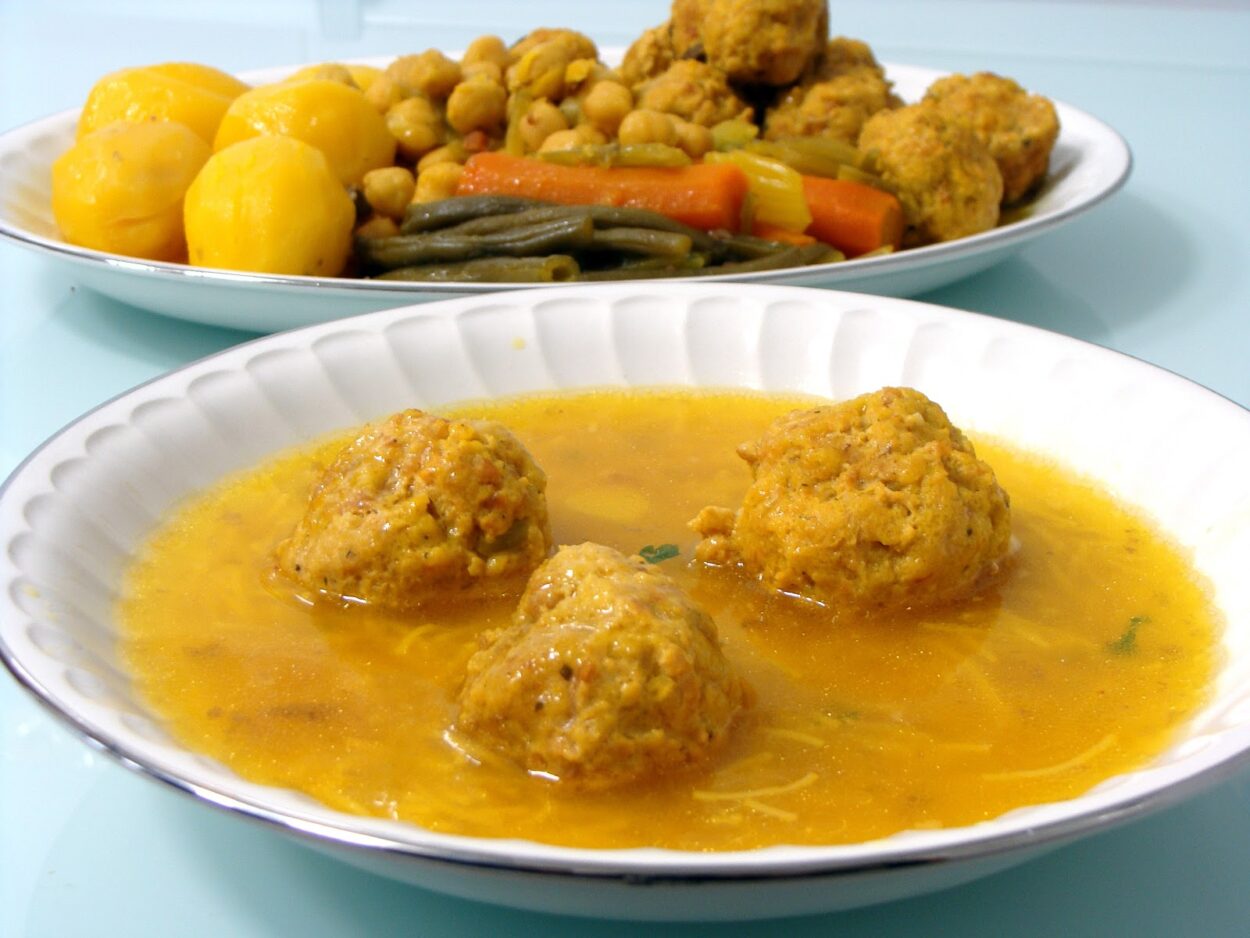
Each region of Spain has its own tradition for the Christmas menu, which is determined mainly by local cuisine, for example on the coast seafood or fish is common and inland, meat plays a more important role such as roasted suckling lamb, however nowadays most regions tend to combine both, especially on Christmas Eve. However, Christmas day in the Valencian community is a day for enjoying a rather special typical dish called ‘Puchero de Nadal’ ó ‘Cocido Navideño’. Effectively it is a stew with giant meatballs but it is enjoyed in two stages. It may seem very simple and rustic but it is a very long meal and takes time to digest. It contains almost everything you could possibly imagine putting in a stew. What makes this stew different from the rest of the stews in Spain is the use of local sausages and local vegetables. The Valencian community is well known for its vegetables and this is well portrayed in the Valencian ‘Puchero’.
As with most traditional recipes, there is nothing written in stone, except using a giant cauldron! So grab the biggest pot you can find otherwise there is no way all the ingredients will fit in. Remember the stock, the meat and the vegetables can all be frozen afterwards so if you have a lot left over, you will, ration it out in Tupperware and freeze it for another day or use it for another recipe as mentioned later on.
For the stew you will need the following :
½ medium sized Chicken (approx. 1,25kg of meat)
2 large meatballs (recipe as follows)
1 piece of bone marrow
1 piece of knee bone
150 grams of beef
1 Blanquet sausage
1 Onion Morcilla sausage
100 grams of pork fat
300 grams of chickpeas (soaked in water overnight)
Saffron
1 stick of Celery, 1 stick of Cardoon, 1 sweet potato, 1 white turnip, 1 yellow turnip, 1 parsnip, 3 potatoes, 3 carrots, 1 leek, 5 runner beans and ¼ cabbage. (As far as the vegetables go, you can chuck in whatever you have at hand, but this is the standard recipe in Valencia)
So, to make the stew it is as easy as cleaning and peeling the vegetables and placing them all in the pot with the meat and the meatballs, except for the carrots, potatoes, runner beans and the morcilla. These need to be held back for later as they cook more quickly. Cover with water and slowly bring to the boil then reduce the heat to low heat and let it simmer for 90 minutes. Remember to skim off the foam that rises to the top. After 90 minutes pop in the rest of the ingredients that were held back and then simmer for another 90 minutes. To make the meatballs all you will need are the following ingredients:
2 eggs.
150g lean minced beef
150g minced pork.
1 sausage (with skin removed)
200g Breadcrumbs
1 tbsp. Fresh chopped parsley
50g Pine nuts
1/2 tsp. Cinnamon powder
10ml fresh Lemon juice
Salt and pepper to taste
Stew net for binding
Cabbage leaves for wrapping up the meatballs.
 12.43.39 - Copy 1.png)  11.38.52 - Copy 1.png)
If you feel like saving some time you can always make the balls the day before. Mix the meat, salt, pepper, 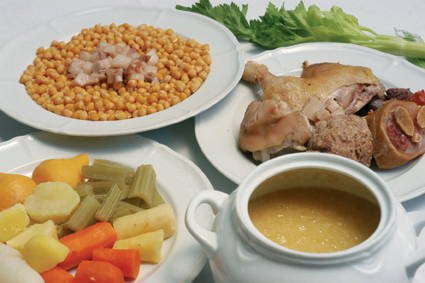 parsley, cinnamon, eggs and pine nuts to taste. Pour the breadcrumbs in and knead it all together until it forms a thick mass. Add the lemon juice and knead it all together again. Separate the meat mass into two parts and then roll it into two large balls. Once you have made the balls wrap each ball in cabbage leaves and then place them inside the stewing net and tie them up tight and add to the rest of the meat for the stew. parsley, cinnamon, eggs and pine nuts to taste. Pour the breadcrumbs in and knead it all together until it forms a thick mass. Add the lemon juice and knead it all together again. Separate the meat mass into two parts and then roll it into two large balls. Once you have made the balls wrap each ball in cabbage leaves and then place them inside the stewing net and tie them up tight and add to the rest of the meat for the stew.
Once the stew is ready it is customary to first enjoy a bowl of soup from the stock cooked either with rice or noodles. Some may add a piece of the meatball to the soup and others may add a bit of everything and then move on to the rest of the meat and vegetables, the choice is yours. It would also be customary to make 'oven-baked rice' (arroz al horno) the following day with the leftovers. So there you have it, a very hearty meal from the heart of Valencia and ideal for this time of year, it may not look very sophisticated but it tastes incredible!
Enjoy!
 3
Like
Published at 4:15 PM Comments (0)
3
Like
Published at 4:15 PM Comments (0)
Magro en Tomate - Pork in Tomato sauce
Friday, December 12, 2025
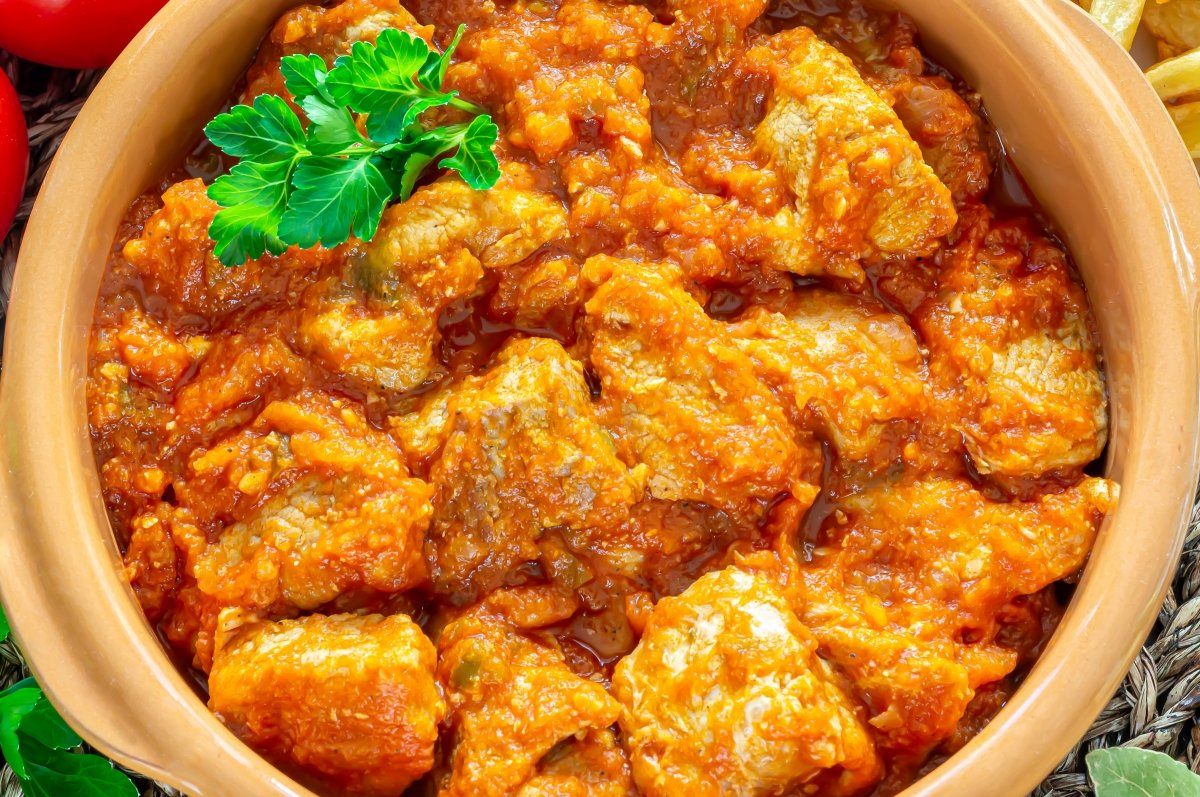
Pork in tomato sauce is one of the many traditional dishes of Spanish cuisine that is made throughout the length and breadth of the territory. With a few very cheap ingredients, you can enjoy this dish either at home, or at the bar as an appetizer or tapa, and always, of course, with a good piece of crusty bread to dip in the sauce.
Preparing it is very easy since it basically involves cooking the meat with a decent amount of tomato. The quality of the latter is important though.
It is important to get some very ripe tomatoes or a very good tomato preserve. During cooking, the sauce is concentrated and reduced while it is impregnated with the juices of the meat, giving it that characteristic flavour that is so popular. In addition, this is one of those stews which tastes even better if you let it rest for a whole day.
To accompany it, you can have white rice for example or even a portion of good chips. Other accompaniments that are common, especially when eaten as a main dish, are fried eggs and fried green peppers, which help to fill out the meal.
Getting hungry?
BASIC INFO:
Preparation time: 10 minutes
Cooking time: 1 hour 10 minutes
Total time: 1 hour 20 minutes
Ingredients for 4 people

800g lean pork meat, chopped
Salt
Ground black pepper
1 large onion
1 Italian green pepper (optional)
4 cloves of garlic
800 g of very ripe natural tomato or canned
4 tablespoons olive oil
150 ml of white wine
1 or 2 bay leaves
parsley (optional)
Sugar (optional)
STEPS:
To prepare this fantastic recipe, we need 800 g of lean pork meat, chopped and ready to cook. However, first, we are going to check it to remove any excess fat that has remained. Generously season with salt and pepper and let it stand while we prepare the vegetables.
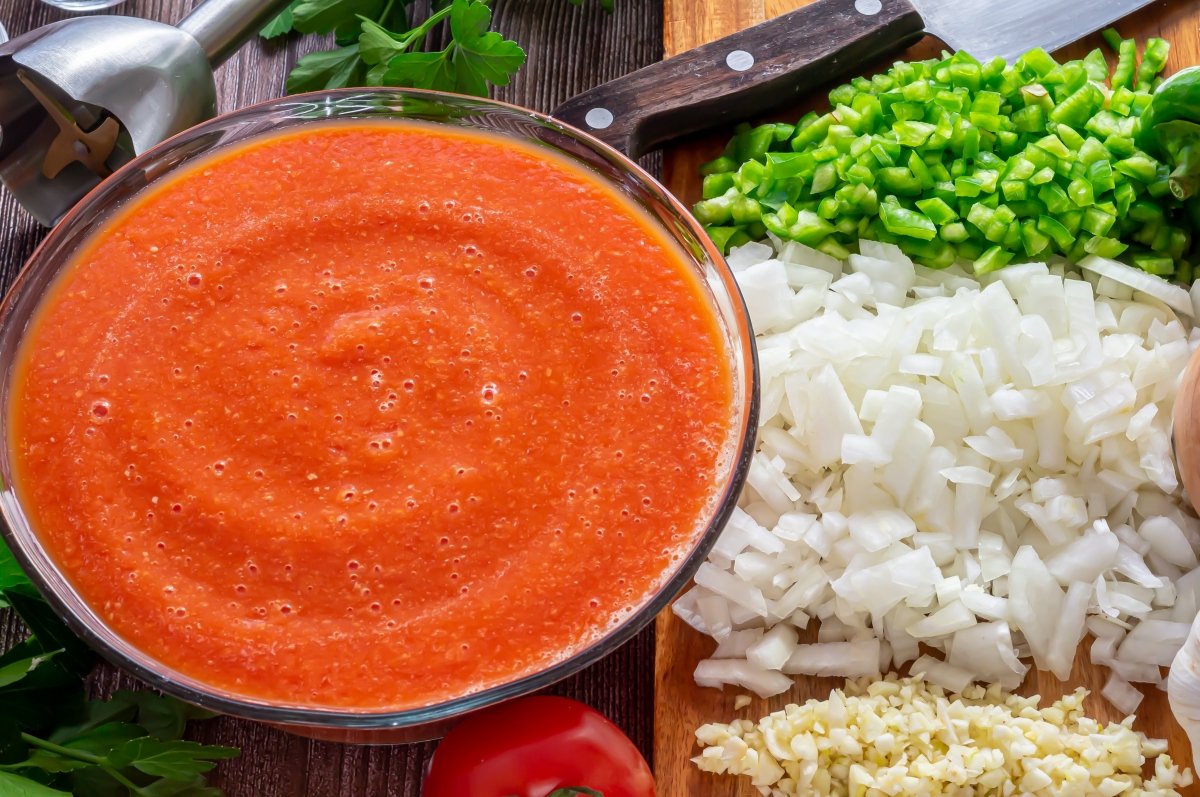
Take 1 large onion, peel it and chop it finely. Optionally, in season, we can add 1 Italian pepper. In this case, we remove the stem, open it in half lengthwise and remove the seeds. We chop it very finely. We also need 4 cloves of garlic, peeled and finely chopped. Finally, we crush 800 g of tomatoes, which can be natural or good quality canned tomatoes. In the first case, we will make sure that they are fully ripe, wash them and remove the stem. To remove the remains of the skins and seeds, pass the tomato through a chinois or fine sieve, pushing with a mortar pestle or with the back of a spoon
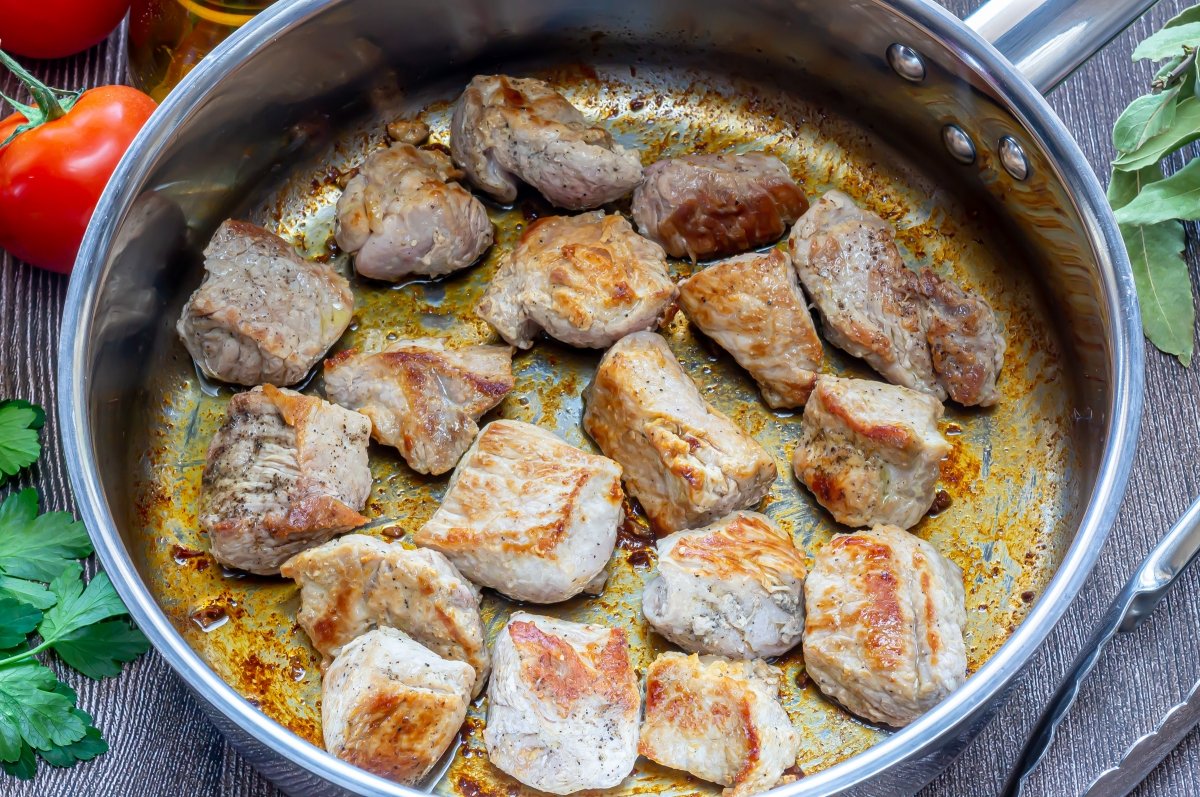
Heat a large skillet or pan with 1 tablespoon of olive oil. When it is very hot, but not smoking, brown the meat over medium-high heat, until browned on all sides. We will do it in two batches because if we put everything in at once the pan will fall in temperature and it will take longer to cook and brown the meat. As the pieces of meat brown, we remove them and put them to one side.
We lower the heat and finish adding the other 3 tablespoons of oil we need. In it we are going to fry the onion with the pepper over medium-low heat, stirring frequently so that it does not burn. We want it to be very poached so we will cook it for about 10 minutes or so.
Once they are very soft and transparent, add the garlic and mix. Let it cook for about 1 minute. At that time, we put the meat back in the pan or pot, along with any of the juices that it may have released, and soak it with 150 ml of white wine, I like to use a Verdejo. Next, we turn up the heat and let it cook so that the alcohol in the wine evaporates. It will take a few minutes.
Cover the meat with the blended tomato. Also add one or two bay leaves, which will give the sauce a very rich flavour. Let it heat up until it starts to bubble. At that moment and before it starts to spit, lower the heat and let it simmer for between 30 and 45 minutes until the tomato has thickened and the meat is tender. To avoid the tomato spitting everywhere, cover the pot with a fine mesh cover, which also allows the sauce to evaporate.
Finally, taste the sauce and rectify with salt and pepper if necessary. We can also add a little finely chopped parsley. Optionally, you can reduce the acidity of the tomato sauce with a little sugar during the cooking stage but check this halfway through. However, if very ripe tomatoes are used and the onion is well poached, it may not be necessary to add any sugar.
Good Luck
 4
Like
Published at 7:48 PM Comments (0)
4
Like
Published at 7:48 PM Comments (0)
Spanish Cheeses You Must Try
Wednesday, November 26, 2025
Of the more than 100 different cheeses produced in Spain, 27 are protected by the "Denominación de Origen Protegida" (D.O.P.) label. In English the most widely used expression which means the same is the description "P.D.O" - Protected Designation of Origin. Several others are still waiting for this status to be granted to them by the Ministry of Agriculture.
In Spain all varieties of cheeses are made: from fresh to extra cured; coagulated with the help of enzymes, lactic acid or a mixture of both; of diverse sizes and shapes; with rinds of various colours, engraved with splendid designs and patterns, covered with mould, smoked, spiced or rubbed with oil. It really is a world of scent and flavour.
Spanish cheese-makers use three types of milk: from sheep, cows and goats. Blends of these kinds of milk are also used to produce their cheeses. This great variety of cheese comes as a result of climatic and geographical differences and from farming customs steeped in age-old traditions. You will find in this pages all of the most important characteristics of all D.O.P. cheeses, as well as those of the most representative cheeses of each category: sheep's milk cheese, cow's milk cheese and goat's milk cheese in addition to various blends and blue cheese, in a sampling of our enormous cheese heritage, which is a reserve of our culture and traditions and places us among the most important cheese-producing countries in the world. Here are the top 10:
Queso Manchego
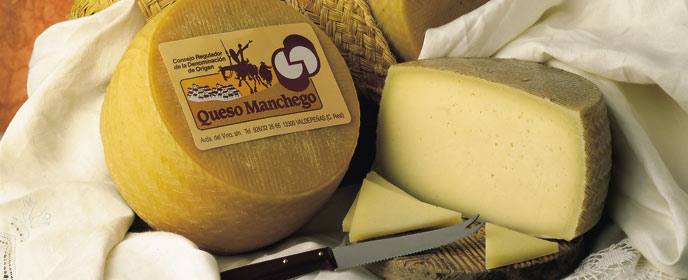
The Manchego is produced in the La Mancha region of Spain, which is also home to Don Quixote. It is made from unpasteurized sheep's milk. It is one of the popular cheeses from Spain, made from sheep's milk. It also comes under the PDO guidelines.
The traditional use of grass moulds leaves a distinctive, characteristic zigzag pattern on the Manchego cheese. Authentic Manchego is only made from the Manchego sheep's milk. Manchego cheese is made from both pasteurized and unpasteurized milk. The farmhouse version is produced from unpasteurized milk while the industrial version is made from pasteurized milk.
The rind is inedible with a distinctive, traditional herringbone basket weave pattern, pressed on it. A typical ear wheat pattern is pressed onto the top and bottom wheels of the cheese. There are specific differences in Manchego cheeses, depending on their ageing period.
Semi Curado - Young Manchego cheese is aged around 3 months are supple and moist. The flavour is fruity, grass, hay with a tangy note.
Curado - Manchego cheese aged for 6 months acquires a caramel and nutty flavour. It has a distinct acidity.
Viejo - Manchego cheese aged for a year becomes crumbly in texture while the interior of the cheese acquires a butterscotch colour. It has a sweet, lingering taste.
Manchego cheeses are best paired with a sherry. Cheeses similar to Manchego are called 'Manchego like cheeses', but the producers cannot legally name the cheese as Manchego.
Queso Cabrales
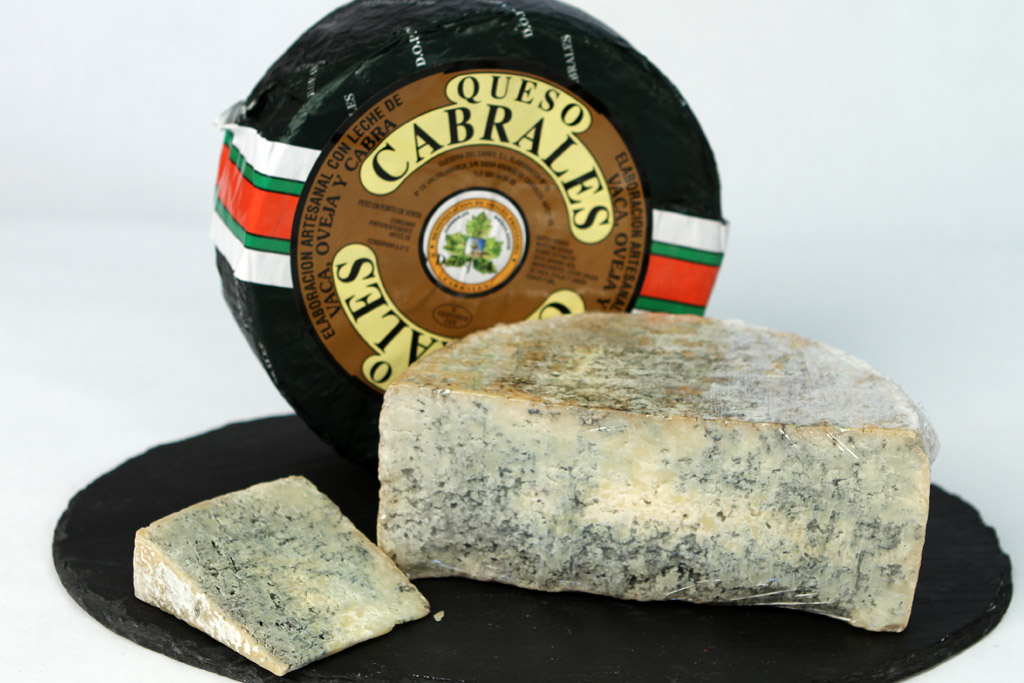
Cabrales, also known as Queso Cabrales, Queso de Cabrales or Cabraliego, is a PDO (Protected Designation of Origin) awarded, Spanish semi-hard, fatty blue cheese, prepared within the administrative region of Cabrales Council and some towns in the Upper Peñamerella region. Both these areas are located at the foot of the Picos de Europa Mountains in Asturias.
The cheese is a mixture of raw cows, goats and sheep's milk aged for between two and four months in naturally formed limestone caves. Chilly and humid conditions in the caves facilitate the growth of bluish-green penicillium mould on this highly prized cheese. Unlike other blue cheeses injected with penicillium, Cabrales cures from the outside of the cheese to the inward.
A finished Cabrales can be characterized by its strong, penetrating aroma and sharp, acidic, slightly salty taste. It pairs well with red wine, fresh figs, salami, sweet sherry and dry sausages. The cheese is treasured as a base for sauces, for melting over grilled or roasted meats and goes well along with baguette slices, crackers, or fruit.
Earlier, a traditional Cabrales was sold wrapped in moist leaves of Acer pseudoplatanus. But today regulation requires the cheese be sold in a dark-green-coloured aluminium foil with the stamp of the PDO Queso de Cabrales. Careful because when you leave the cheese for too long you get small white worms coming out of it, but this doesn't stop some eating it!
Queso Torta del Casar
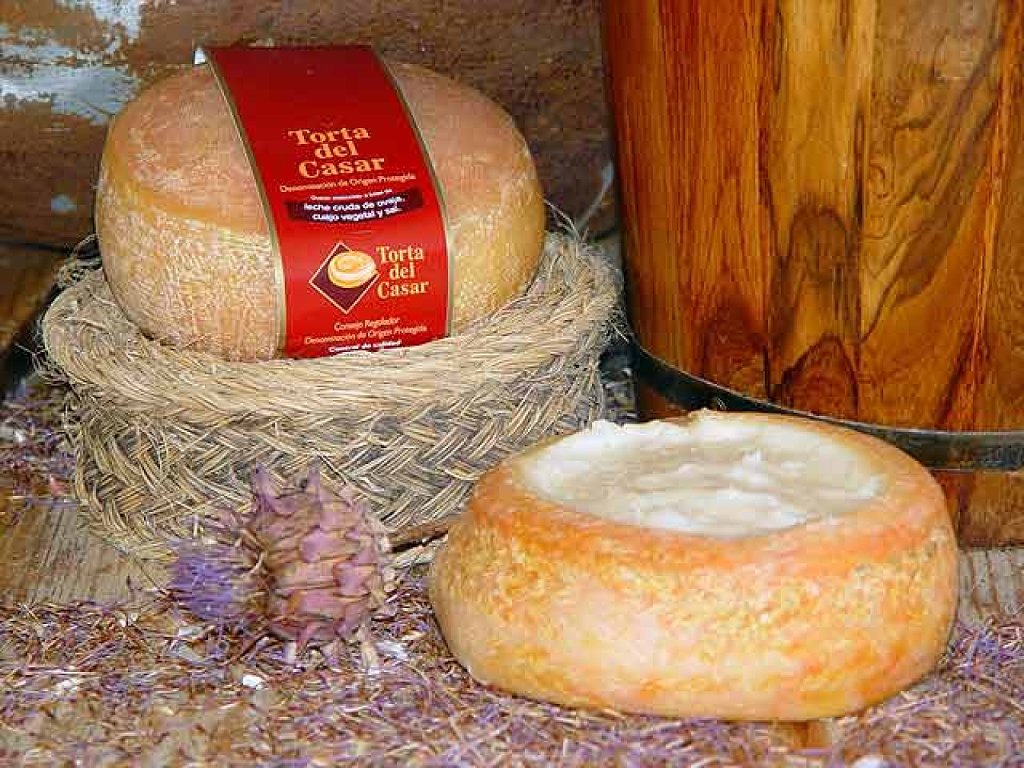
Torta del Casar PDO is a Spanish cheese made from raw sheep’s milk in the Extremadura region, near the Portuguese border. Named after Casar de Cáceres, its city of origin, the shepherds who made the cheese used to call it ‘atortao’ because it was shaped like a cake or ‘torta’. Torta del Casar is a very rare cheese since it is made from milk of Merino and Entrefina sheep that yield very low milk and it takes a herd of sheep to make 1 kg of the cheese.
Torta del Casar is a vegetarian product coagulated with cardoon, a wild thistle which adds a slightly bitter note to the rich and slightly salty tasting cheese. The cheese is aged for at least 60 days upon which it develops a semi-hard, yellow to ochre crust and a soft, spreadable, creamy, almost runnier paste. Its insides are yellowish in colour and the aroma very unique. Torta del Casar should be enjoyed as an appetizer or a dessert, spread on bread with a glass of dry, red wine.
Queso de Valdeón
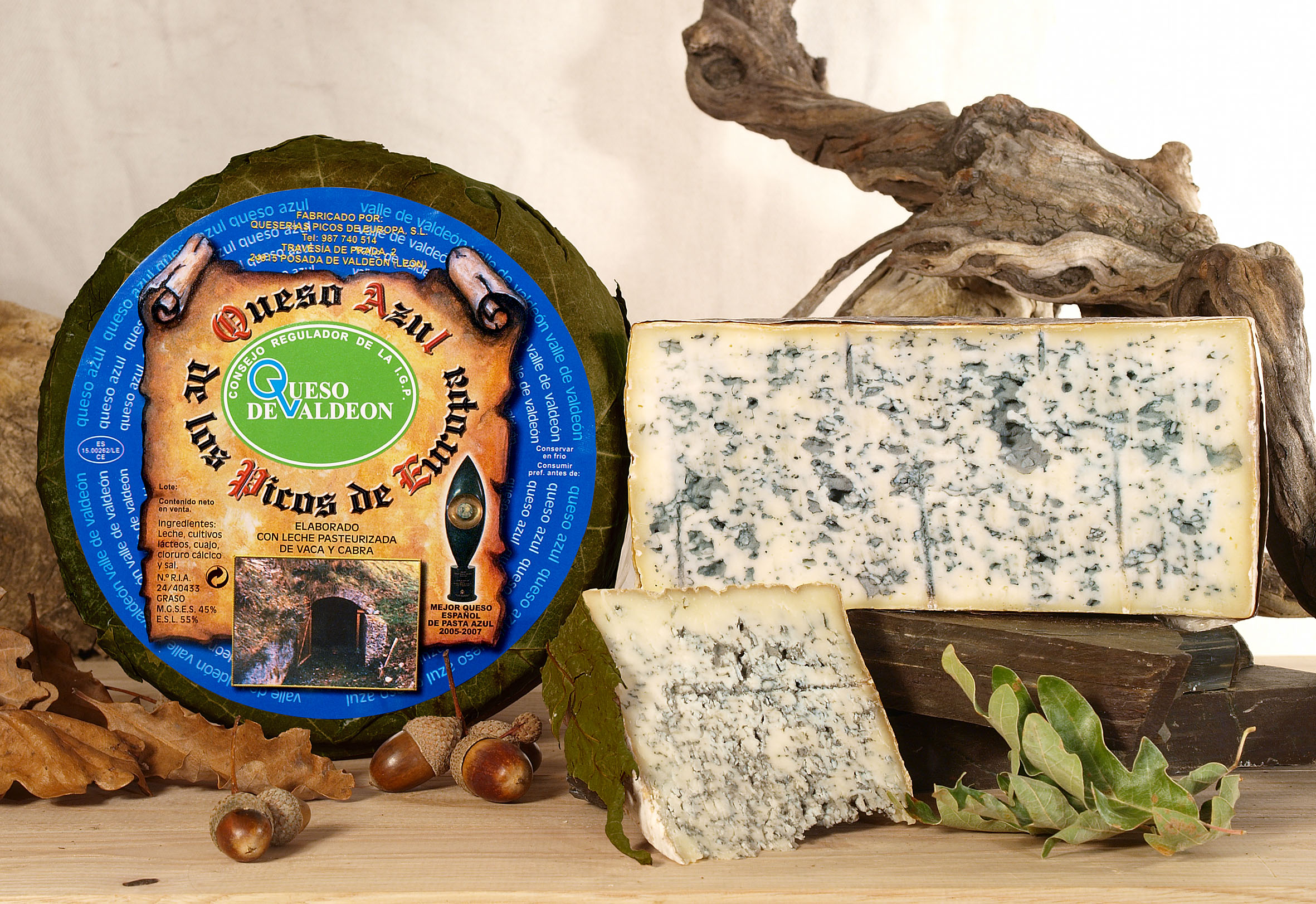
Valdeon is a Spanish blue cheese produced in Valdeon Valley of Castile-Leon region of northwestern Spain. Made all year round with cow or goat’s milk or a mixture of both, the cheese has very dense blue veining and comes wrapped in maple or chestnut leaves. Since leaf wrapping is no more allowed these days, it comes wrapped in leaf printed aluminium foil. Queso di Valdeon has been awarded a status of Protected Geographical Indication (PGI) to regulate the production, processing and preparation of the cheese. In 2005, the Ministry of Agriculture, Fisheries and Food granted the cheese an award for best Blue Veined Spanish Cheese.
A bold and salty cheese, Valdeon uniqueness lies in its manufacturing process, which includes long and traditional maturing in the cold, damp cellars until the cheese reaches a mature or medium mature age. The pate of Valdeon has a soft, granular texture and pale yellow colour and is full of small cavities filled with blue moulds. Covered by a coarse, inconsistent rind in dark grey shades with little red marks, Valdeon is very strong and spicy in taste similar to Roquefort. A powerful smelling cheese, Valendon's greasy, buttery paste is perfect for preparing any kind of blue cheese sauce. The rich smell of the cheese makes a good companion for fresh fruit and strong red wine or sherry.
Queso Gamoneu
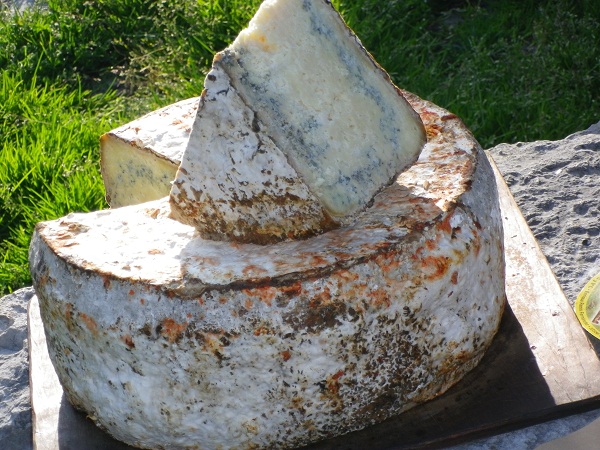
Gamoneu or Gamonedo is a Spanish PDO cheese produced from a blend of cows, sheep's and goat's milk. Originating in the high altitude areas of Asturias, there are two varieties of the cheese depending on the location where it is made and seasonal production. Gamoneu made from June to September in the cabins of Los Picos de Europa and Cangas de Onis is called Gamonéu del Puerto. On the other hand, Gamonéu del Valle is made in small dairies in the lower areas of both these councils all year long.
Gamonéu is a fatty cheese with a yellowish-whitish pate and greenish-bluish Penicilliun outcrops on the edges. Its thin rind is a distinctive sienna colour acquired during the smoking process. Texturally, Gamonéu is hard or semi-hard, firm and friable with small, irregular eyes scattered spread throughout the pate. The taste is slightly spicy and smoky with a buttery, nutty persistent aftertaste. Its aroma is clean with soft hints of smoke that intensify with maturation.
Queso Idiazábal - smoked
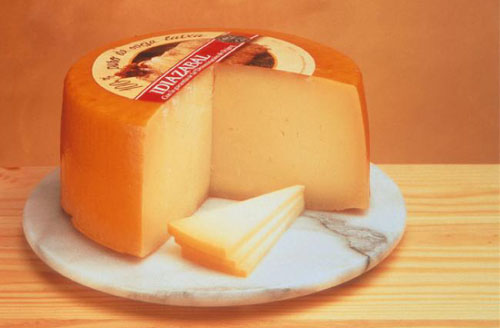
Idiazabal is a traditional, farmhouse, hard cheese made from raw milk of Latxa or Carranza sheep in the Basque and Navarra regions of northern Spain. Named after the village of Idiazabal, the cheese received Spanish D.O. (Denominacion de Origen) in 1987.
In summer, the sheep migrate to higher pastures to graze on the blossoming, new grass. During this time, the artisanal cheesemakers milk the sheep, make the cheese and leave it in the rafters to mature. At the end of summer when the cheesemakers return back to the lowlands with their sheep, the cheese has ripened and is ready for sale.
Idiazabal is produced in the shape of a cylinder, with a smooth and hard natural rind that is pale yellow to amber in colour. The cheese has a compact texture, with a few pinprick holes. It is dry, but not crumbly, and feels pleasantly oily in the mouth. The rind carries the marks of the wooden moulds in which it was drained. The characteristic, smoky flavour is the result of the cheeses having been stored near the fireplaces. There were no chimneys in the simple mountain huts, so the cheeses absorbed the sweet, aromatic smoke. The taste of the cheese is reminiscent of burnt caramel and bacon. It pairs well with red wine and cider.
Queso Tetilla
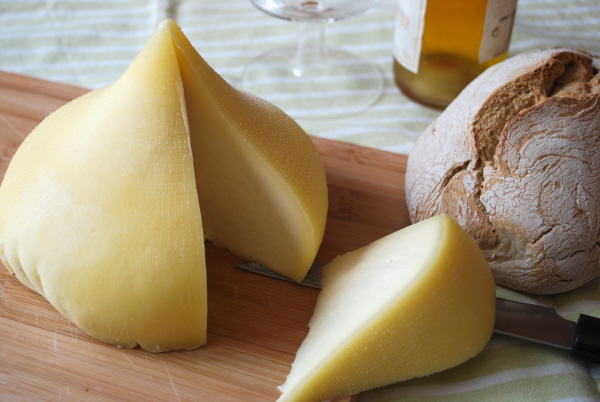
Tetilla is a typical Galician cheese made from the herd of Friesians, Alpine Browns and Rubia Gallega cows. Since 1992, it has been one of the four kinds of cheese that received DOP recognition. The name Tetilla is Galician for “small breast”, which describes the shape of the cheese – a pear-shaped cone topped by a nipple.
This cheese has a pale yellow, thin, natural rind or sometimes no rind can be seen at all. Its texture is soft, thick and smooth with scatterings of air pockets. Yellowish ivory in colour Tetilla has a creamy mouthfeel with buttery, slightly bitter and tangy flavours surrounding the palate. The maturing, which takes place between 10 and 30 days, happens in the hot and humid climate of Galicia.
Try Tetilla with a dry full-bodied wine, sherry, young whites, manzanilla and especially the Galician whites - albariño or Ribeiro. Spanish love their cheese with quince paste, fruit, crackers, baked dishes and bread.
Queso de La Peral

La Peral is a gently blued pasteurized cow and sheep milk cheese from Asturias in northern Spain. This rare and delicious cheese has been produced for a little over a century. The sheep milk component gives this firm cheese a little olive oil flavour and a pleasantly pungent aroma. Also known as Queso Azul Asturiano, La Peral is made by the Lopez Leon family. The wheels are aged for sixty days just to the point that the blue begins to develop. La Peral resembles an Italian Gorgonzola. It has a slightly crumbly texture that leads to a refreshing finish on the palate. Along with other bigger wines, we recommend that you try pairing this outstanding blue cheese with Tempranillos, Cabernet Sauvignons, Gamays, Ports or Spanish dessert wines.
Queso de Los Beyos
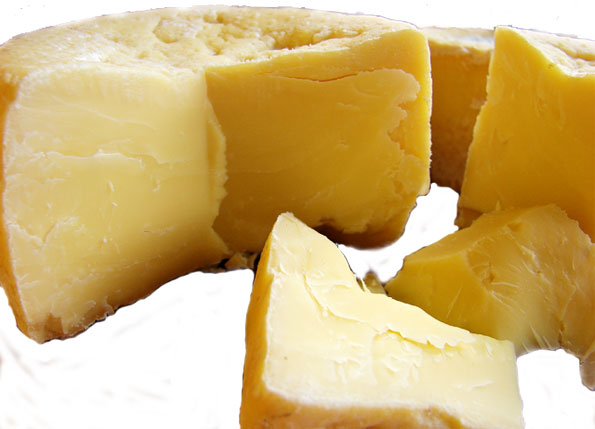
Los Beyos is one of our speciality cheeses from Asturias, aged for 2 months and made from pasteurized cow`s milk. Los Beyos is truly an artisanal beauty produced in the mountains of Amieva. It takes its name from "el desfiladero de los Beyos". This place is a beautiful but extremely narrow and curvy mountainous area in Asturias that follows through into Castilla-Leon. There is a constant debate as to which specific area in Asturias is where this cheese originated. Dense and compact. Rustic and artisan. We hope you find the texture and flavour as interesting and as much as a rollercoaster ride as we do. The cheese itself is drier and flakier but still retains a cured and rich flavour with a sharpness that does not linger for very long. And good news! Los Beyos pairs just as nicely with a Martini as it will with Chardonnay and Tempranillo.
Queso Zamorano
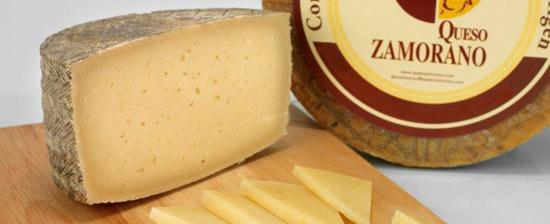
Zamorano is a famous Spanish sheep’s milk cheese made in the region of Castile-Leon, Zamora. This hard cheese takes almost 6 months to mature fully. It has a pale-yellow colour with a crumbly texture and contains 45% fat.
Zamorano has a buttery and nutty taste, which is served as a table cheese with White, Red as well as Zinfandel wine. It gets characteristic flavour because of the breed of sheep – the small, scruffy Churra and the Castilian sheep.
Due to a distinctive zigzag pattern and cylindrical shape, Zamorano appears similar to Castellano or Manchego.
There you have it, 10 fantastic cheeses from Spain that must be savoured if you are a cheese fanatic!
 5
Like
Published at 7:50 PM Comments (0)
5
Like
Published at 7:50 PM Comments (0)
The Secretary's Chicken
Friday, November 14, 2025
Even though winter is around the corner, I thought I would share with you a wonderfully warming chicken stew recipe, but with a very peculiar name: The Secretary's Chicken - "Pollo a la Secretaria". It earned this peculiar name as a result of the cook's forgetfulness. A group of friends from the Jaén town of Alcalá la Real, who met in a farmhouse to celebrate the day of San Roque were supposed to be sitting down to enjoy a typical rice dish when, halfway through the preparation, the cook was going to add the rice and realised that he had forgotten to bring this seemingly important ingredient. Fortunately, one of the attendees, who happened to be the secretary for the local town council suggested that the chicken could still be cooked even without the rice and that he should just crack on with the recipe without it, and the result was a complete success, so the dish was baptised The Secretary's Chicken. It really is an easy recipe and ever so tasty, so let's give it a go:
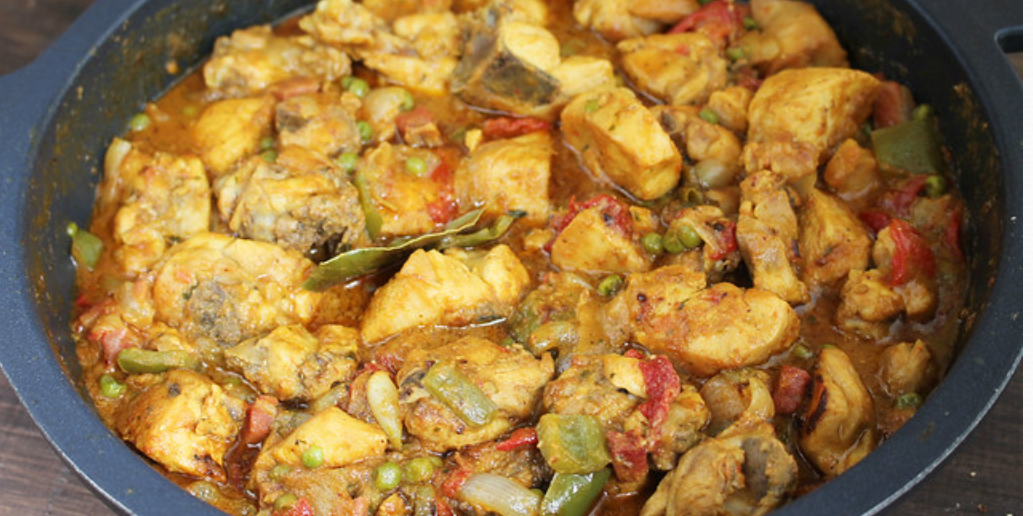
Ingredients for 4 people:
1 Free-range chicken chopped up into pieces (about 1,5 kg)
75 g Green peas
200 g Serrano ham cut into small cubes
6 Garlic clove
Saffron - a few strands
200 ml Chicken stock
1 Chicken liver (if you buy the chicken from a butcher, say you want the liver too)
3 Onions (sliced)
200 ml White wine
Extra virgin olive oil three tablespoons
2 Bay leaves
Fresh parsley - a few sprigs
1/2 Large green pepper (sliced)
1/2 Large red pepper (sliced)
1 Large grated tomato
Start by frying the peeled garlic cloves (whole, without chopping them up) together with the chicken liver for a couple of minutes. Once they are ready, blend the garlic and liver with a few sprigs of parsley and a tiny bit of water in a blender. Once you have a thick paste put it to one side. Be careful not to add too much water. Start with a half a tablespoon and add accordingly.
In the same saucepan with which you fried the garlic, brown the chicken pieces. Brown them really well, if you need to add a little more oil, do so, but make sure they are nicely browned. This is what adds extra flavour to the dish.
Once fried, put the chicken to one side. Using the same saucepan again, fry the onions and the peppers. When they begin to brown and soften, add the grated tomato and the white wine.
Now, put the chicken pieces back in that you fried earlier and add the garlic and liver paste, the bay leaves and the saffron. Mix all together and then add the peas, the ham cubes and the chicken stock, let it simmer together for about 25 minutes on medium heat until the chicken is tender. Taste for salt and add if necessary.
Remove it from the heat and let it rest for about 5 minutes.
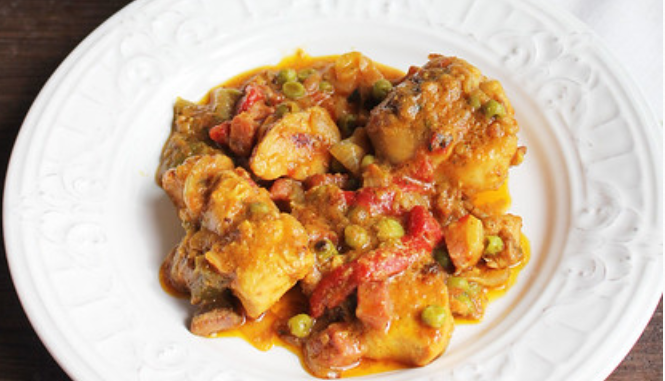
I like to serve this dish with fresh potato chips (not frozen) fried in extra virgin olive oil, but you could also serve it with white rice or on its own with some crusty bread.
Enjoy!
 5
Like
Published at 9:03 PM Comments (0)
5
Like
Published at 9:03 PM Comments (0)
Pringá - A lasting memory of Seville
Friday, November 7, 2025
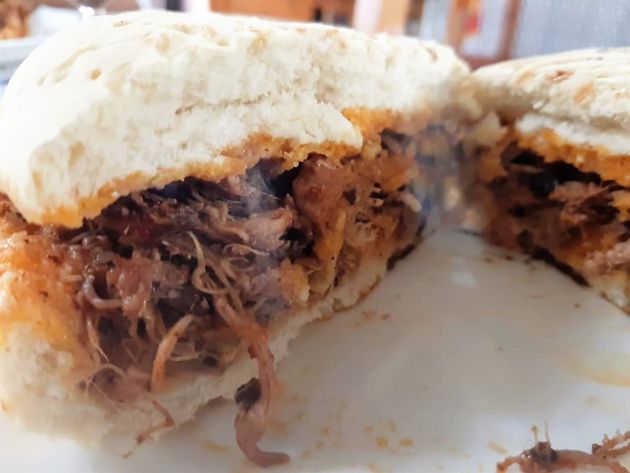 In Andalusia and especially in Seville, there is an amazing snack which I discovered called "Pringá". Essentially it is a slice of bread, sometimes lightly toasted, with a dollop of leftover stew all mixed together. It sounds awful, but it's heavenly! In Andalusia and especially in Seville, there is an amazing snack which I discovered called "Pringá". Essentially it is a slice of bread, sometimes lightly toasted, with a dollop of leftover stew all mixed together. It sounds awful, but it's heavenly!
The soft tender meat is rescued from the pot and with a little love the most amazing mixture is created. As with all homemade cooking recipes, flavours will change from household to household depending on what is added to the stew pot, but a standard recipe involves mixing bacon with chicken, beef, and pork.
The key to this recipe is, of course, that the raw materials are of the best possible quality and that the cooking process is slow and controlled so that no meat is too soggy or dry. You can pretty much make a Pringá from any type of stew, but perhaps it is from the Madrid stew and the Andalusian stew that you get the most meat to play with. If you are creative, you can add some spice to the mix, although it is not something that is done anywhere, cumin or black pepper works really well.
If you find it is very fatty or too strong, just add some pickled gherkin which accompanies it perfectly. So this is what you will need to create a great Pringá.
For the stew you will need the following :
½ medium-sized free-range Chicken (approx. 1,25kg of meat)
1 piece of brisket (about 200g)
1 thick piece of pancetta
1 thick piece of bacon Iberico
1 chunk of serrano ham off the bone.
1 bone of serrano ham
1 piece of bone marrow
1 Blanquet sausage
1 Onion Morcilla sausage
100 grams of pork fat - "tocino "
300 grams of chickpeas (soaked in water overnight)
Saffron
Vegetables:
1 stick of Celery, 1 stick of Cardoon, 1 sweet potato, 1 white turnip, 1 yellow turnip, 1 parsnip, 3 potatoes, 3 carrots, 1 leek, 5 runner beans and ¼ cabbage.
As far as the vegetables go, you can chuck in whatever you have at hand.
So, to make the stew it is as easy as cleaning and peeling the vegetables and placing them all in the pot with the meat, except for the carrots, potatoes, runner beans and the morcilla. These need to be held back for later as they cook more quickly. Cover with water and slowly bring to the boil then reduce the heat to low heat and let it simmer for 2 hours. Remember to skim off the foam that rises to the top. After 2 hours pop in the rest of the ingredients that were held back and then simmer for further 90 minutes. Once ready, separate all the meat from the stock and let it cool to one side.
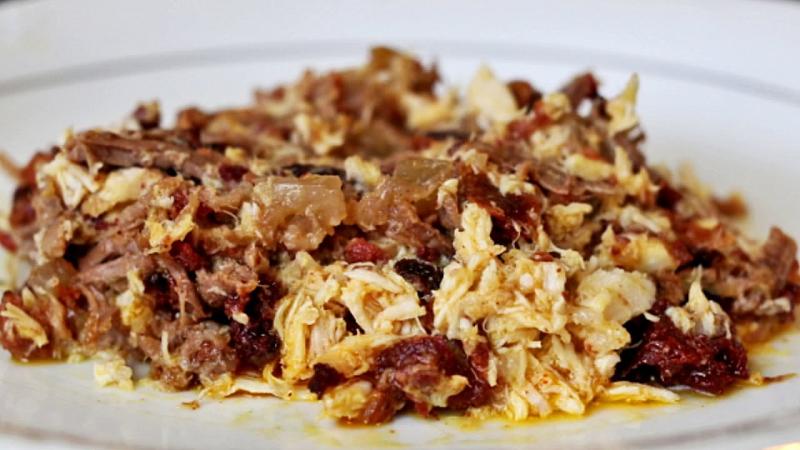
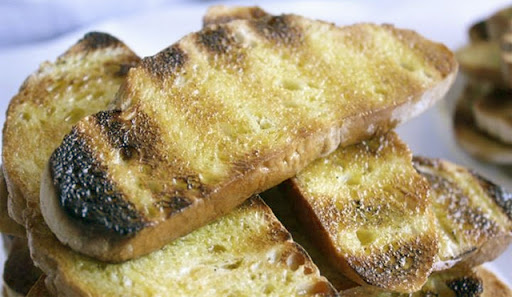
While the cooked meats and pork fat are still warm or hot, shred the chicken, pancetta, bacon, beef and serrano ham and the "tocino" with the help of a fork or chopping it up a little with a knife, until you get a mashed-up mixture of frayed meats. Add a little broth until the desired texture is achieved, it should not be too wet or too dry but it needs to have a thick consistency that is spreadable.
Taste and rectify with salt if necessary, now would be the time to add the spices, if you want.
Cut a slice of bread and toast it slightly. In Andalucia, a soft roll is also used - called a "mollete" - to make a sandwich. Whichever way you decide, add the gooey mush and spread it well then heat everything up, under the grill for about 2 minutes and serve immediately.
Enjoy!
 4
Like
Published at 7:46 PM Comments (1)
4
Like
Published at 7:46 PM Comments (1)
Arroz al Horno - Spanish Baked Rice Recipe
Friday, October 31, 2025
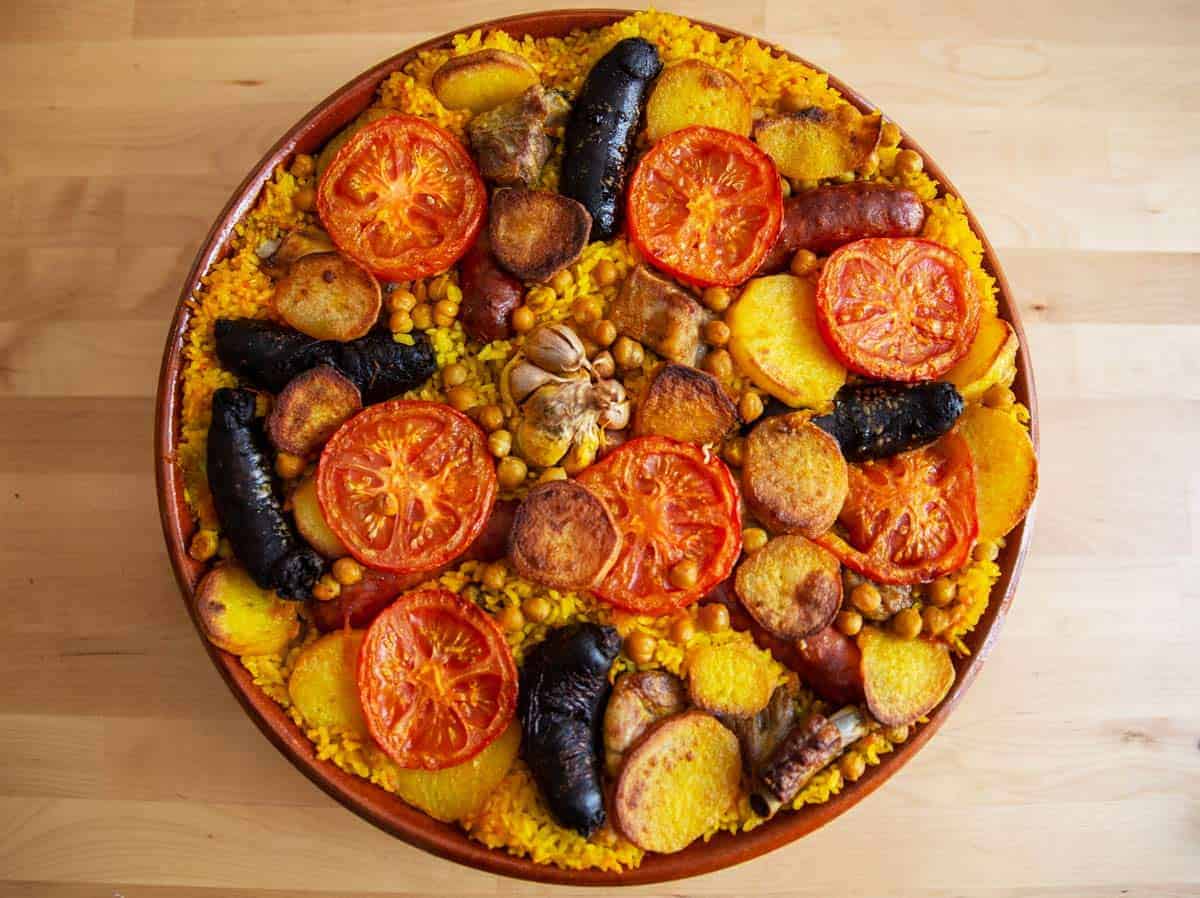 Rice dishes are one of my favourites, but Valencian oven-baked rice or “Arroz al Horno” when I first came to Spain wasn’t exactly one of them until I tasted the real deal. I took a disliking to it mainly because it was often too dry for my liking. However, when I learnt the tricks to get it right, everything changed. It was just a process of practise making perfect, to be honest. There is a fine line between 'ok' rice and 'great' rice and I must admit it has taken me several attempts to even get close to a great “Arroz al Horno”. As with all traditional dishes they tend to be a lot of work but fortunately, this dish isn’t that time consuming and the result is just fantastic. It is actually quite simple. Valencian cuisine is normally eclipsed by the Paella but this dish is very much part of the Valencian’s staple diet. Traditionally it was prepared with the leftovers from the “cocido”, a meat and vegetable stew, but nowadays everyone makes it with fresh ingredients. Another of its advantages is that it doesn’t make as much mess as a paella when you are cooking indoors! Rice dishes are one of my favourites, but Valencian oven-baked rice or “Arroz al Horno” when I first came to Spain wasn’t exactly one of them until I tasted the real deal. I took a disliking to it mainly because it was often too dry for my liking. However, when I learnt the tricks to get it right, everything changed. It was just a process of practise making perfect, to be honest. There is a fine line between 'ok' rice and 'great' rice and I must admit it has taken me several attempts to even get close to a great “Arroz al Horno”. As with all traditional dishes they tend to be a lot of work but fortunately, this dish isn’t that time consuming and the result is just fantastic. It is actually quite simple. Valencian cuisine is normally eclipsed by the Paella but this dish is very much part of the Valencian’s staple diet. Traditionally it was prepared with the leftovers from the “cocido”, a meat and vegetable stew, but nowadays everyone makes it with fresh ingredients. Another of its advantages is that it doesn’t make as much mess as a paella when you are cooking indoors!
This dish is cooked in a large flat earthenware dish. If you don’t have one you can also cook it in a non-stick baking pan. However, the result is better in an earthenware dish. The ingredients you will need for this recipe are the following:
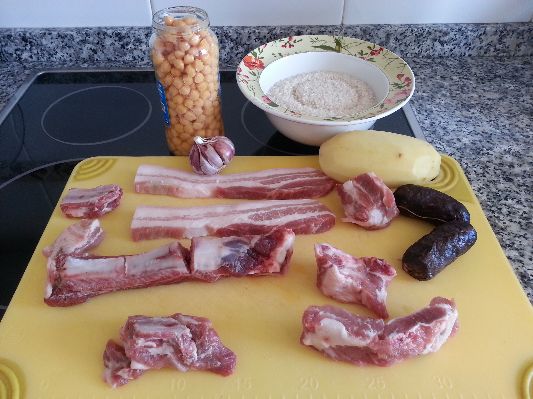
Ingredients for 4 people :
400g Round Valencian Rice – the same you use for a paella - Bomba variety is the easiest to use as it will not go too soft, it is a lot more forgiving if you overcook it or get eth measurements wrong.
300g Pork Ribs chopped up into small pieces
300g Pancetta (thick-cut bacon) chopped up into small pieces.
200g Grated tomato
4 Onion Morcillas (Spanish black pudding)
1 large tomato cut into thick slices
1 large potato cut into thick slices
300g Cooked Chickpeas (garbanzos)
1 whole head of garlic
Saffron
Paprika
1 litre approx. Chicken and vegetable stock
Extra Virgin Olive Oil (preferably Picual for frying)
(In Valencia you can buy "Arroz al Horno meat packs" already made up in some supermarkets so if you find one you only need to pull together the rest. I like to add a little extra pancetta if I buy a pack as they don't normally put much in them)
It looks like a lot of ingredients but it is fairly straight forward so I really encourage you to give it a go.
The first step is to get the oven on full heat so it starts heating up while you are preparing the rest and start heating the stock. It needs to be almost boiling when you add it to the pan. Add a little saffron to the stock to give it a bit of colour and when the stock is hot add the chickpeas to it to heat them up, keep the stock hot. If you have homemade stock fantastic but the chances are you won't and I didn't, so I used as most people do, a ready-made stock from the supermarket.
Grab a frying pan, put in some extra virgin olive oil and start to fry the potatoes slices. They don’t need to be cooked just half cooked and slightly browned. Remove them and place them to one side.
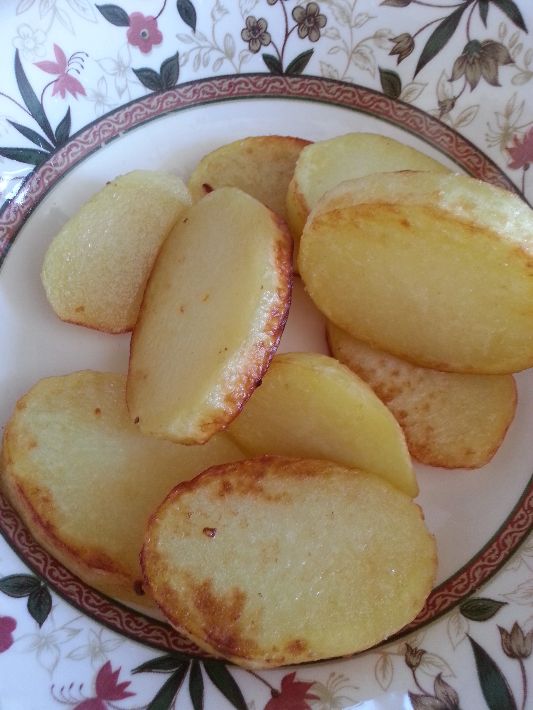 . . 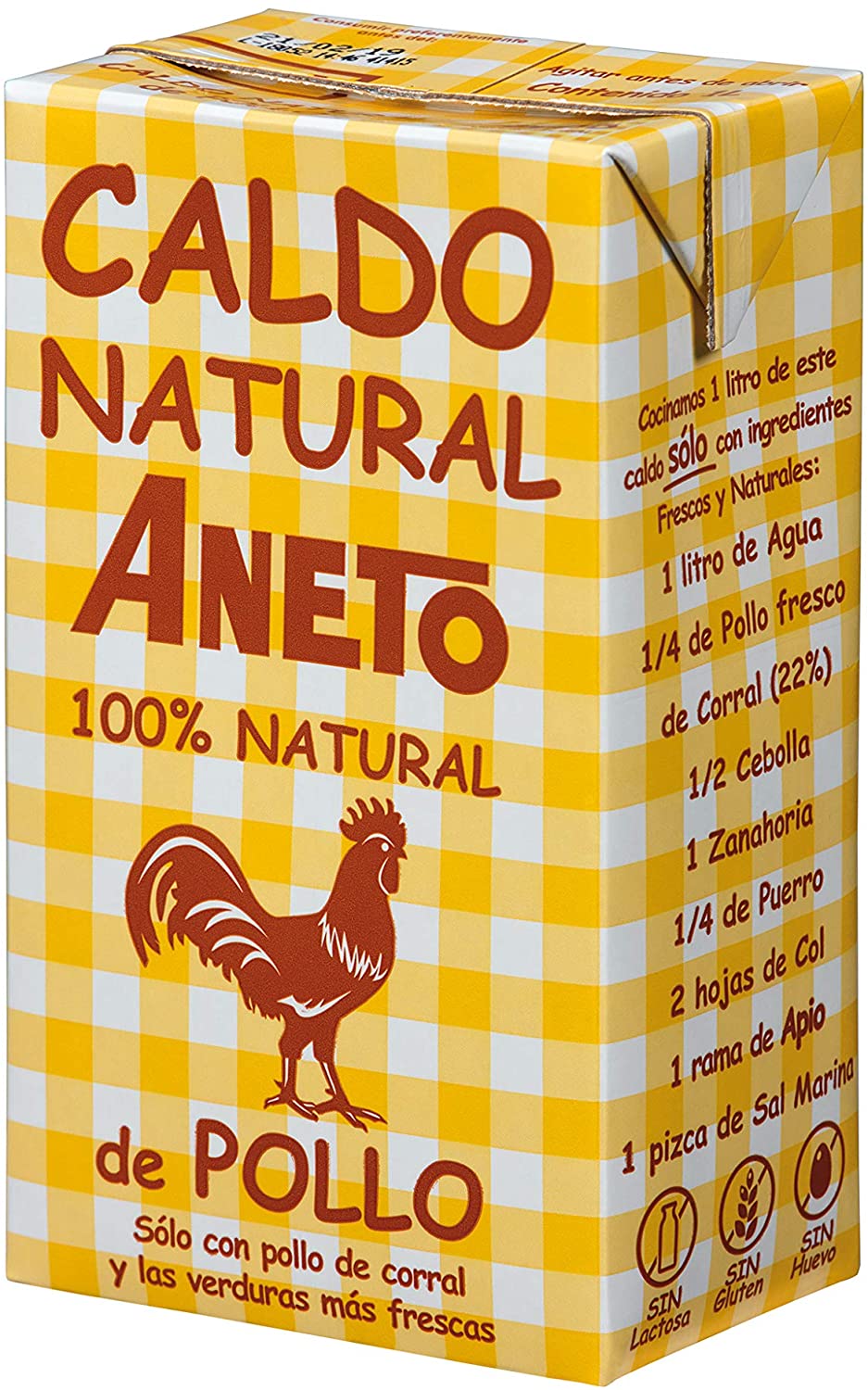
Now you need to fry the pork ribs. They need to be really well cooked so they go brown and crispy around the edges. Once the ribs are turning slightly brown pop in the whole garlic with the pancetta until it goes crispy too. You need to put the pancetta in slightly later as it cooks faster than the ribs. Once ready remove it all from the pan and place the meat and the garlic in the earthenware dish.
.jpg) 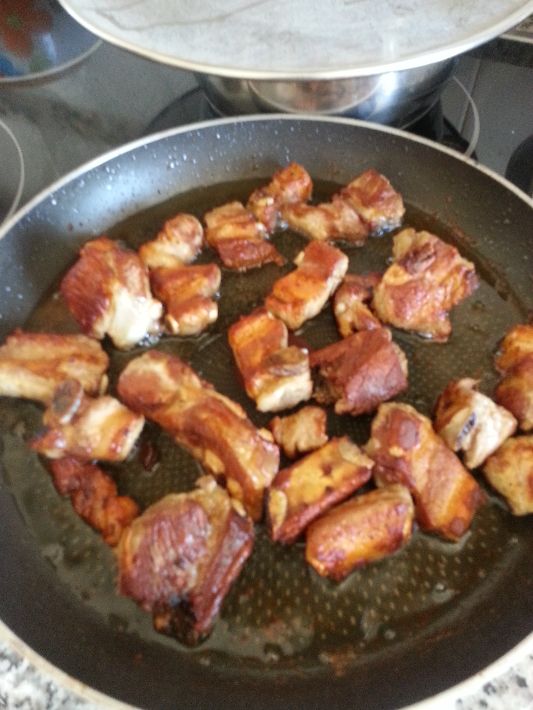
Take the morcillas and quickly fry them, without cutting them up, in the fat that has been left in the pan, just for a couple of minutes and take them out. You are not cooking them now just sealing them and giving the fat a bit more flavour. The next step is to add the grated tomato to the oil with a teaspoon of paprika and fry it gently in the remaining oil for a minute or two. At this point, you need to add the rice to the frying pan to seal it for a minute or so before putting it in the earthenware recipient. This will soak up all the fat and flavour from the pan and is essential for the final result. At this point, you need to add the hot stock and the chickpeas to the earthenware dish as quickly as possible, move the ingredients around so they are all evenly in place and put the potato and tomato slices on top. Now place it immediately in the oven on full heat for 20 min (250ºC). During the last five minutes of the cooking time turn on the grill so it browns the top. When it is ready all the stock should have evaporated. Remove it from the oven and let it sit for five minutes before serving.
As with all rice dishes the amount of stock or water is the key to success. The easiest way to measure the correct amount of rice and the correct amount of stock is to find a coffee cup or a small glass. I have one that holds approximately 100g of rice so I use one cup per person. The rule of thumb is for every cup/glass of rice you will need two cups of stock minus one from the total number. So if you are using 4 cups of rice you would need 7 cups of stock (using the same cup measurement).
The secret to this recipe is time management and really cooking the meat well. The objective is to get all the ingredients into the oven while they are still hot so the oven doesn’t have to heat them up but starts cooking straight away from the minute it goes in.
.jpg)
Now, just serve up and enjoy!
 5
Like
Published at 9:24 PM Comments (0)
5
Like
Published at 9:24 PM Comments (0)
Truffles are on the menu again...
Friday, October 24, 2025
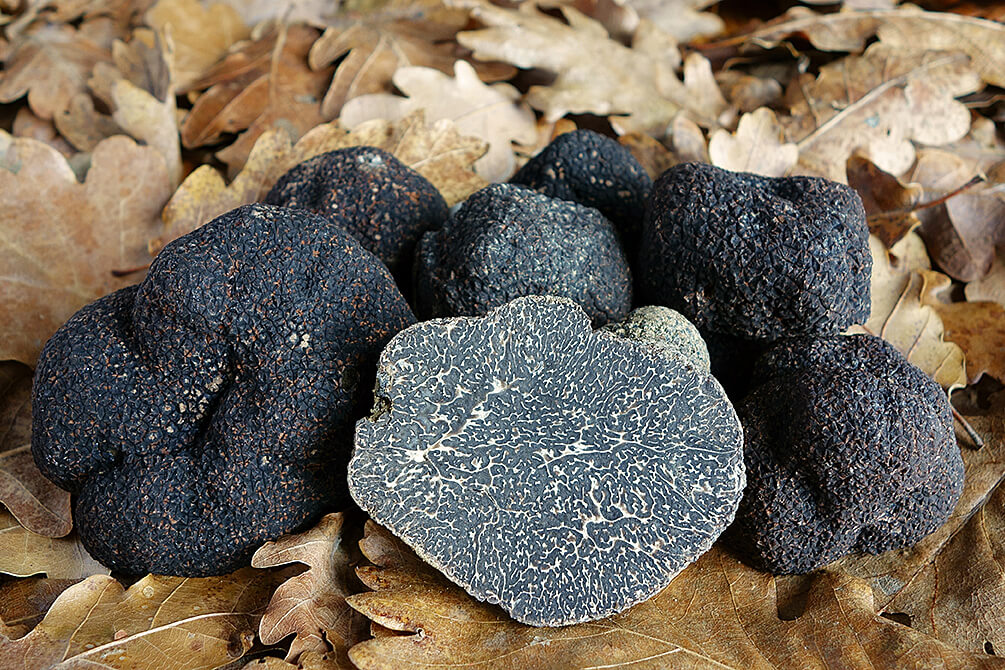
European white truffles can sell for as much as €5000 a kg, making them and their fellow fungi the most expensive food in the world. In Spain, the black truffle of Teruel oscillates between €500 and €1000 kg and is considered one of the finest in the world. However, if you are looking for a very special touch to your meal, this is it.
Truffles are hypogynous fungi. This class of fungi needs to join to the thinnest roots of certain superior plants such as holm oaks without which they are unable to live, a natural symbiosis. The life of a truffle is linked to that of the symbiont tree it lives with. Truffles have a balloon-like shape, rough and irregular and variable in size and weight. Their aspect and size depend on the season: in spring you can hardly see them, in summer they are bigger in size and pale red in colour and by the end of the autumn they start to mature and get brown and black with reddish spots first and totally black by the end of the season.
Nowadays, over a hundred truffle species are known around the world, however, only a few of them are edible and appreciated. In the province of Teruel, there are two kinds of truffles that are harvested.
Firstly, the Tuber Melanosporum Vitt, which is commonly known as Winter black truffle or Black truffle of Teruel. The body of the black truffle normally has the size of a walnut or a tennis ball, rounded or irregular and lobed. The flesh of the black truffle is thick, compact and grey or violet coloured. It has very thin white veins, clearly marked and branched. They give off a characteristic smell, which is intense and pleasant, and their taste is unique, unmistakable and characteristic. The harvesting season of this truffle has just started and continues until March. It is the black truffle variety, which is most valued in the market, due to its culinary value.
Secondly, there is the Tuber Aestivum Vitt which is also known as Summer white truffle. It can be variable in size; from a walnut to a tennis ball. It also has a round or irregular shape, as the black truffle, but sometimes with small concavities.
The main difference between Tuber Aestivum Vitt. and Tuber Melanosporum Vitt. is their inner part or flesh (gleba). The Tuber Aestivum Vitt also has a thick and fleshy gleba but it is white, yellow or ivory coloured. The smell and flavour of the summer truffle are also pleasant and characteristic, though less strong. This truffle has less culinary value and it is considered Tuber Melanosporum’s younger sister, so to speak and is harvested between May and August.
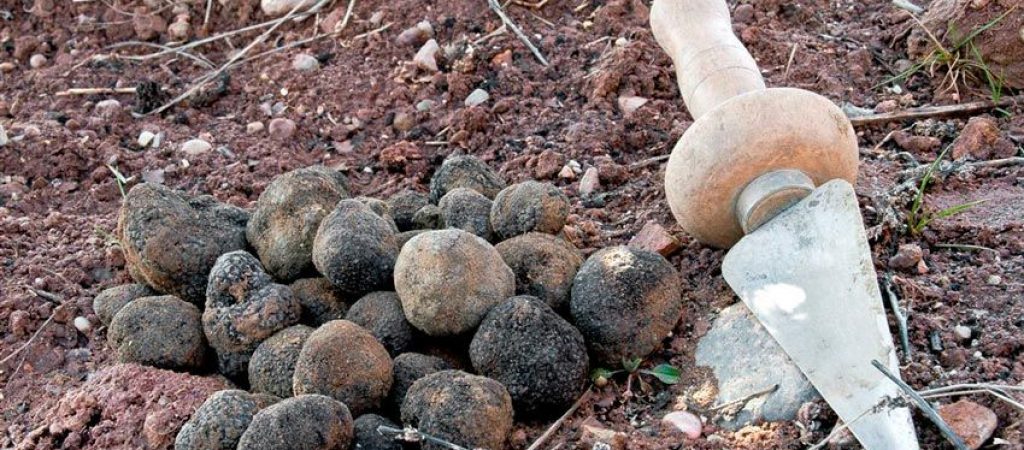

These two species must not be confused with other truffle substitutes that are also in the market and their culinary quality cannot be compared to cheaper species. You should check the label when you buy a truffle, as it should state the species and Latin name.
The Black truffle of Teruel is considered one of the best truffles in the world. The Mediterranean climate of Teruel, characterised for being extreme, moderately warm and dry, with cold winters owing to the altitude, promotes the growth of suitable vegetation. Although dry, Teruel receives the necessary rainfall that combined with the arid and chalky soil and the experience of the farmers, makes Teruel the Spanish province with the best conditions for producing high-quality truffles.
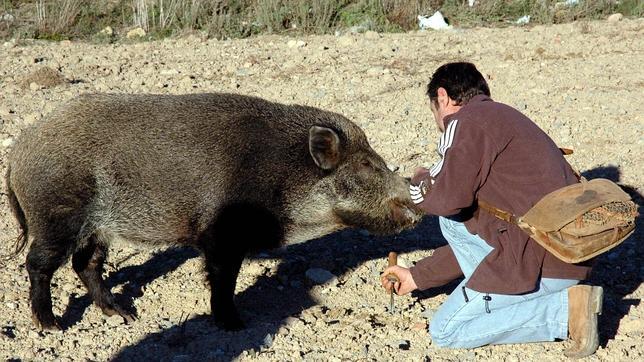 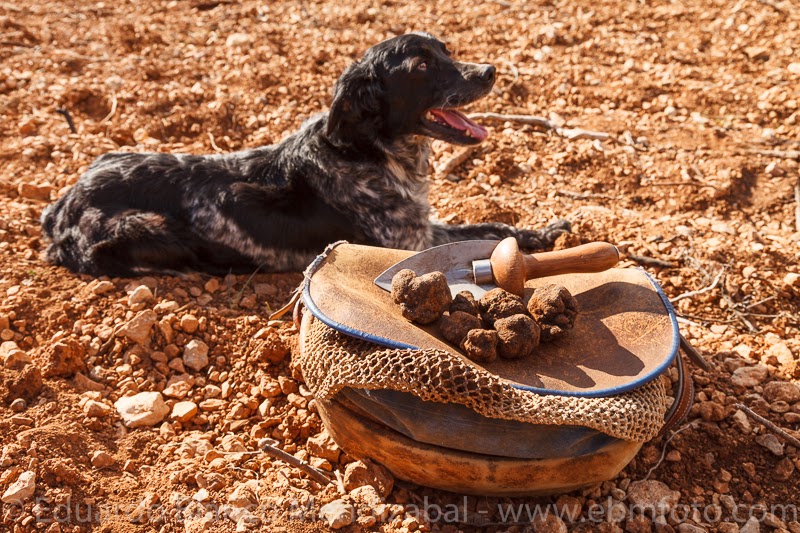
The truffle of Teruel, which is a subterranean fungus, is harvested with the aid of dogs that have been previously trained for this hard job. They can be different kinds of pure breed or cross-breeds, such as a Pointer or a Labrador retriever. The dog must be young, affable and obedient, medium-sized if possible and with hard hair to resist the low temperatures and the continuous rubbing up against the shrubs. Training a dog to find truffles is not an easy task and requires a lot of patience. The dog’s training begins with games: basically, you throw objects and then the dog has to find them and bring them back to you. Normally balls made up of clothes hiding a small portion of truffle inside are used. The animal also needs to be stimulated by eating small portions of truffle, so that it gets familiar with the smell of the valuable fungus.
Afterwards, the trainers will hide truffles under the soil several hours before the daily training session. This is done so that the smell of the truffle impregnates the soil and this way it resembles the real conditions of nature.
Every day, at the beginning of the training session, the dog is taken to the place where the truffle was hidden some hours before and then the animal is encouraged to search and scratch the land. When the dog finds the truffle it will be shown the fungus and allowed to smell it. Then, the dog is rewarded, which could be anything from a piece of bread to very small bits of cheese, dry food or even a portion of its favourite treat. The dog needs to be stimulated with patting and games; however, it is never forced too much as it can get tired soon. Little by little, the smell of the truffle will become familiar to the dog and it will need 2 or 3 years of training and practise before it becomes a “professional seeker” of truffles. We all know that pigs were used in the past, but there was no way of training them not to eat their finds…so dogs were employed.
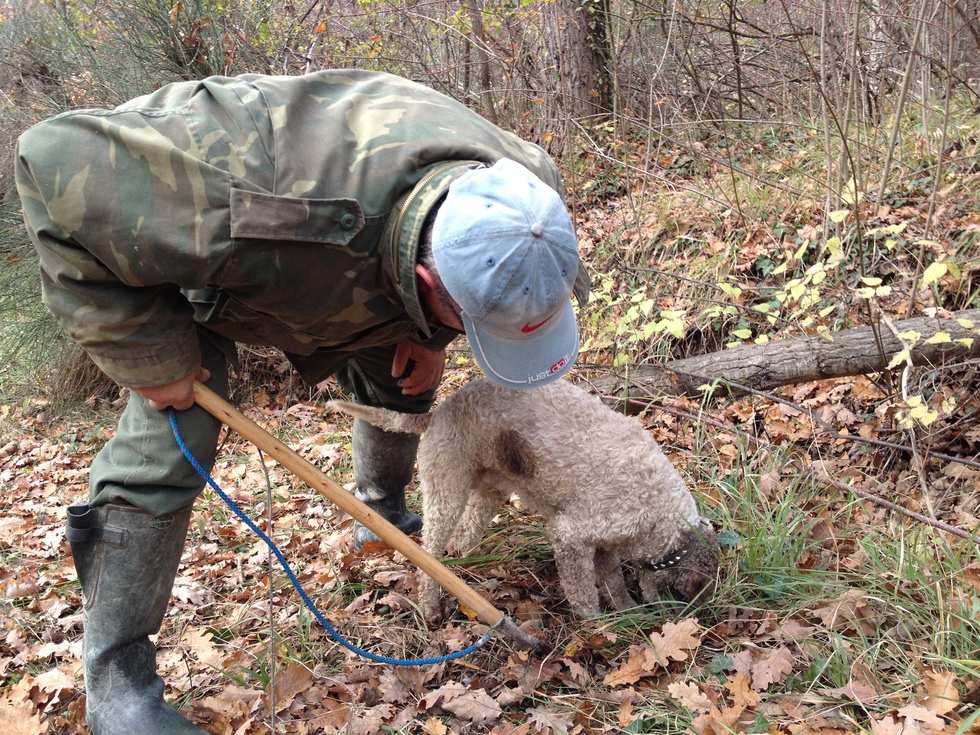
When a dog is searching out a truffle it goes around the producer trees with its nose stuck to the soil until it detects where the mature truffle is, then the dog scratches into the earth with its front legs until the order to stop is heard. The harvester extracts the truffle with the aid of special machetes; narrow machetes that are not pointed. He will dig carefully and unearth the truffle, covering again the hole with the same earth extracted before and after showing it to the dog he will give it a reward. The dog will not detect the truffle until it is sufficiently mature. Thus, it can pass over the truffle several times but never show any indication that the truffle is there.
As it is consumed in small amounts, its nutritional value is a secondary issue. However, this is a low-calorie food, with just 30 calories per 100gr, very digestive and many would say famous for its aphrodisiac powers…
The black truffle of Teruel turns any simple recipe into an exquisite delicacy, which is just unforgettable. This delicacy is treasured by the most demanding gurus of the national and international cuisine and by lovers of good gastronomic dishes. Its peculiar smell and taste, which has a strong personality, should not be mixed with other kinds of food that would mask its characteristics, for instance, garlic or vinegar.
If you use a black truffle to prepare a hot dish, it should be added at the end, as it does not require much cooking. This truffle combines well with red meat, all kinds of game, pasta, rice, eggs and so on.
But I will share a very simple truffle sauce to accompany a rib-eye steak or an “entrecote de buey” in Spain.
You will need for four servings:
250ml of liquid cream
2 shallots
2 tsp. of butter
10gr of Teruel black truffle (finely grated)
 12.56.28 - Copy 1.png) 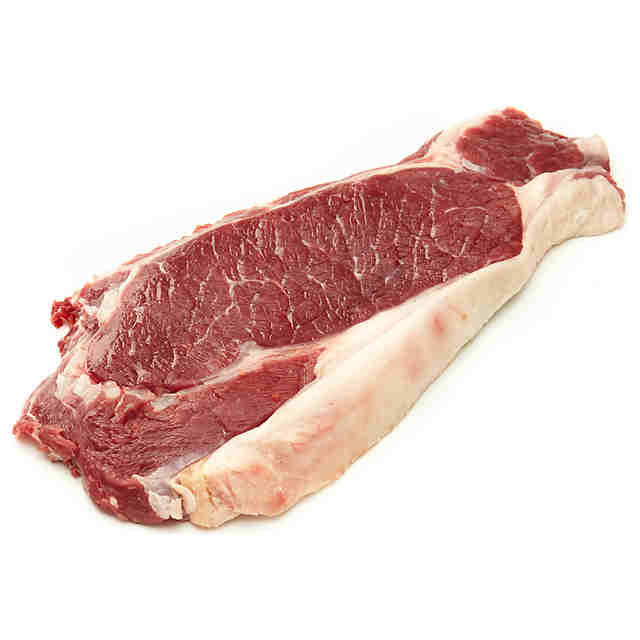
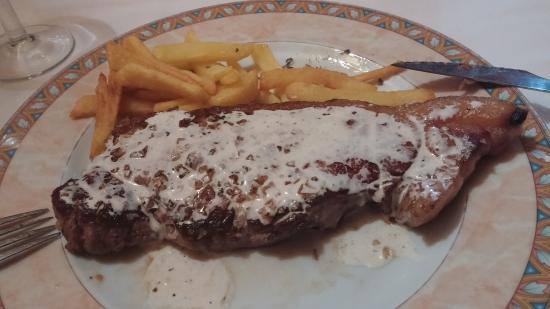
Simply dice up the shallots, melt the butter in a small frying pan and pop them in, cook them for about 4-5 minutes and then add the cream. Then just add the finely grated truffle and stir the cream for a couple of minutes. Make sure you do this once the steaks are almost ready, the truffle doesn’t need much cooking time and it will continue to cook in the hot cream if you leave it standing for too long. Pour the sauce over the steak and serve with chips or steamed vegetables.
Enjoy.
 2
Like
Published at 10:47 PM Comments (1)
2
Like
Published at 10:47 PM Comments (1)
Carrilleras de Ternera - Beef Cheeks in Red Wine - Never Fails!
Friday, October 17, 2025
There are certain dishes that define traditional cuisine, dishes that are slow-cooked, rich in flavour, and perfect for cold days. The Carrilleras de Ternera Guisadas con Vino Tinto (Beef Cheeks Stewed in Red Wine) is one such recipe. This cut of meat, once braised, transforms into a meltingly tender, gelatinous, and luxurious piece, enveloped in a deep, aromatic sauce.
This traditional recipe is surprisingly easy to make and yields a deeply satisfying meal. The secret lies in the long, slow cooking process that allows the meat to become incomparably soft and the red wine to impart its robust character to the final sauce.
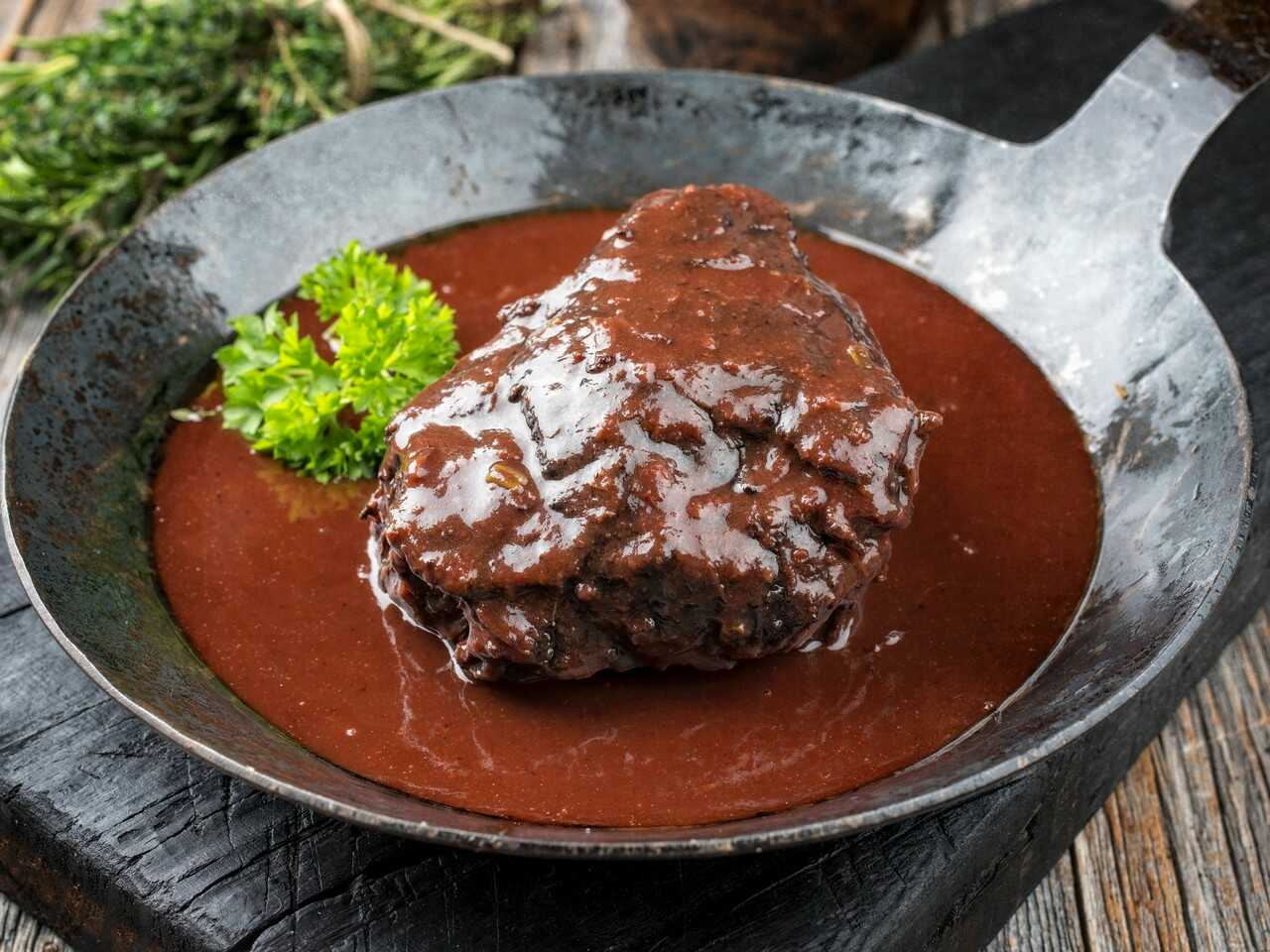
The Humble Origin and Enduring Tradition
The story of Carrilleras is rooted in the Spanish culinary principle of aprovechamiento (making use of everything). Historically, beef or pork cheeks were considered a humble cut, often overlooked in favour of prime steaks and roasts. In traditional Spanish kitchens, particularly in rural areas, this cut—along with other parts like shanks or tails—was prized by cooks for its unique texture.
The muscle tissue in the cheek is dense, but it is marbled with a high amount of collagen. Braising the cheeks involves long, slow heat in a liquid base. This process breaks down the tough collagen into gelatin, which gives the final dish its signature melting tenderness and adds a luxurious, velvety body to the sauce. This 'guiso' is a staple of Spanish 'cocina tradicional', embodying comfort food perfected over generations.
Carrilleras de Ternera Guisadas con Vino Tinto (Traditional Beef Cheeks in Red Wine)
|
Serves
|
4 people
|
|
Difficulty
|
Easy
|
|
Prep Time
|
20 minutes
|
|
Cook Time
|
1 hour 30 minutes
|
|
Total Time
|
1 hour 50 minutes
|
Ingredients
|
Quantity
|
Ingredient
|
|
2
|
Beef Cheeks (Carrilleras de Ternera), whole
|
|
200 g
|
Onion, chopped
|
|
2
|
Carrots, chopped
|
|
2 cloves
|
Garlic, chopped
|
|
200 ml
|
Red Wine (a good quality, full-bodied wine)
|
|
450 ml
|
Beef Broth (Caldo de Carne)
|
|
100 ml
|
Extra Virgin Olive Oil
|
|
1 leaf
|
Bay Leaf (Laurel)
|
|
To taste
|
Salt and Pepper
|
|
Optional
|
A small sprig of Aromatic Herbs (Thyme, Rosemary)
|
|
Optional
|
Flour (for dredging)
|
Instructions
-
Prepare the Meat: Clean the beef cheeks, removing any excess skin. Season with salt and pepper. Lightly flour them (optional).
-
Seal the Cheeks: Heat the olive oil in a large casserole. Sear the cheeks on all sides until browned, then remove and set aside.
-
Sauté the Vegetables: Lower the heat. Sauté the chopped onion, carrots, and garlic until soft. Add the bay leaf and aromatic herbs.
-
Deglaze with Wine: Return the cheeks to the pot. Pour in the red wine and bring to a boil, letting it cook for about 10 minutes to allow the alcohol to evaporate.
-
Braise: Add the beef broth. Bring to a simmer, cover the casserole, and cook for 30 minutes. Flip the meat, cover, and cook for an additional 20 minutes.
-
Reduce Sauce: Remove the lid and let the stew simmer for about 15 minutes to reduce and thicken the sauce.
-
Finish the Sauce: Remove the beef cheeks. Pass the sauce and vegetables through a food mill (pasapuré) or blend until smooth.
-
Serve: Slice the cheeks and drizzle generously with the sauce.
Serving Suggestion
Serve with creamy homemade Mashed Potatoes or Roasted New Potatoes. Garnish with fresh, chopped parsley or herbs.
 (1) (1) (1).png)
Ingredient Variations For Your Stew
While the classic recipe is wonderful, the dish is forgiving and can be easily adapted based on what you have on hand or what flavour profile you prefer:
|
Component
|
Classic Ingredient
|
Variation Options
|
|
Meat
|
Beef Cheeks (Carrilleras de Ternera)
|
Pork Cheeks (Carrilleras de Cerdo) are a very common alternative; they are often fattier and cook slightly quicker. Lamb or Goat Shoulder can also be used, adjusting the cooking time for tenderness.
|
|
Wine
|
Dry Red Wine
|
Sherry: A dry Oloroso or Amontillado provides a nuttier, more complex depth, a popular choice in Southern Spain (Andalusia). White Wine: A dry, crisp white wine (like Verdejo or Albariño) can be used for a lighter-colored, less intensely flavoured sauce.
|
|
Aromatics
|
Onion, Carrot, Garlic, Bay Leaf
|
Mushrooms: Sautéing wild mushrooms (like Boletus or Shiitake) with the vegetables adds a deep, earthy flavour. Citrus Peel: Add a strip of orange peel during the braising process for a subtle, fragrant lift to the sauce.
|
|
Thickening
|
Pureed Vegetables/Flour
|
Dark Chocolate/Cocoa: Towards the end, dissolve a small square of high-quality dark chocolate (70% cocoa or higher) or a teaspoon of unsweetened cocoa powder into the sauce. This doesn't make it taste like chocolate, but it deeply enhances the colour and richness of the sauce's flavour.
|
|
Alternative Thickener
|
Pureed Vegetables
|
Instead of flour, some traditional recipes use a couple of slices of stale bread (lightly fried or toasted), which are added to the stew and then pureed with the vegetables to create a velvety, binding sauce.
|
Ultimately, the Carrilleras Guisadas al Vino Tinto is more than just a recipe; it is a testament to the power of slow cooking and simple, quality ingredients. This dish transforms an often-neglected cut of meat into a centrepiece of flavour and texture, embodying the warmth, history, and generosity of traditional Spanish cuisine. Whether you stick to the classic preparation or experiment with a touch of sherry or dark chocolate, this hearty stew promises a profoundly satisfying and meltingly tender meal that is sure to become a cherished favourite.
 2
Like
Published at 11:03 PM Comments (0)
2
Like
Published at 11:03 PM Comments (0)
Almost..9th of October - Day of The Valencian Community
Friday, October 3, 2025

The Day of the Valencian Community (Día de la Comunidad Valenciana) marks the anniversary of King James I of Aragon's re-conquering of the city of Valencia from Moorish forces in 1238. It is also the Day of Saint Dionysius, a traditional festival for lovers, the Valencian “Valentine’s Day”.
The custom on this day is to give the person you love the ‘mocadorà or mocaorà, which consists of a knotted silk scarf with miniature marzipan candies in the shapes of fruits and vegetables inside.
The most widespread version of the origin of this tradition is that Jaume I and his wife, Violante of Hungary, on their triumphal entry into the city of Valencia, after defeating the Muslims on October 9, 1238, were met by their inhabitants with gifts of fruits and vegetables from the local orchard and farms, wrapped in silk handkerchiefs.

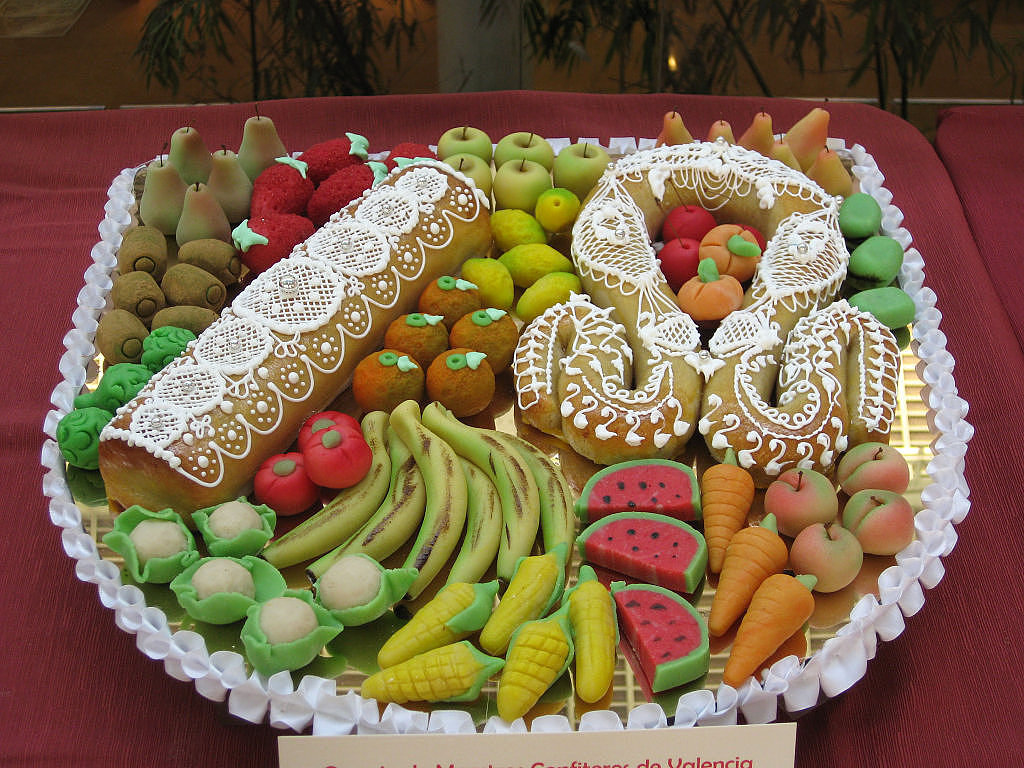
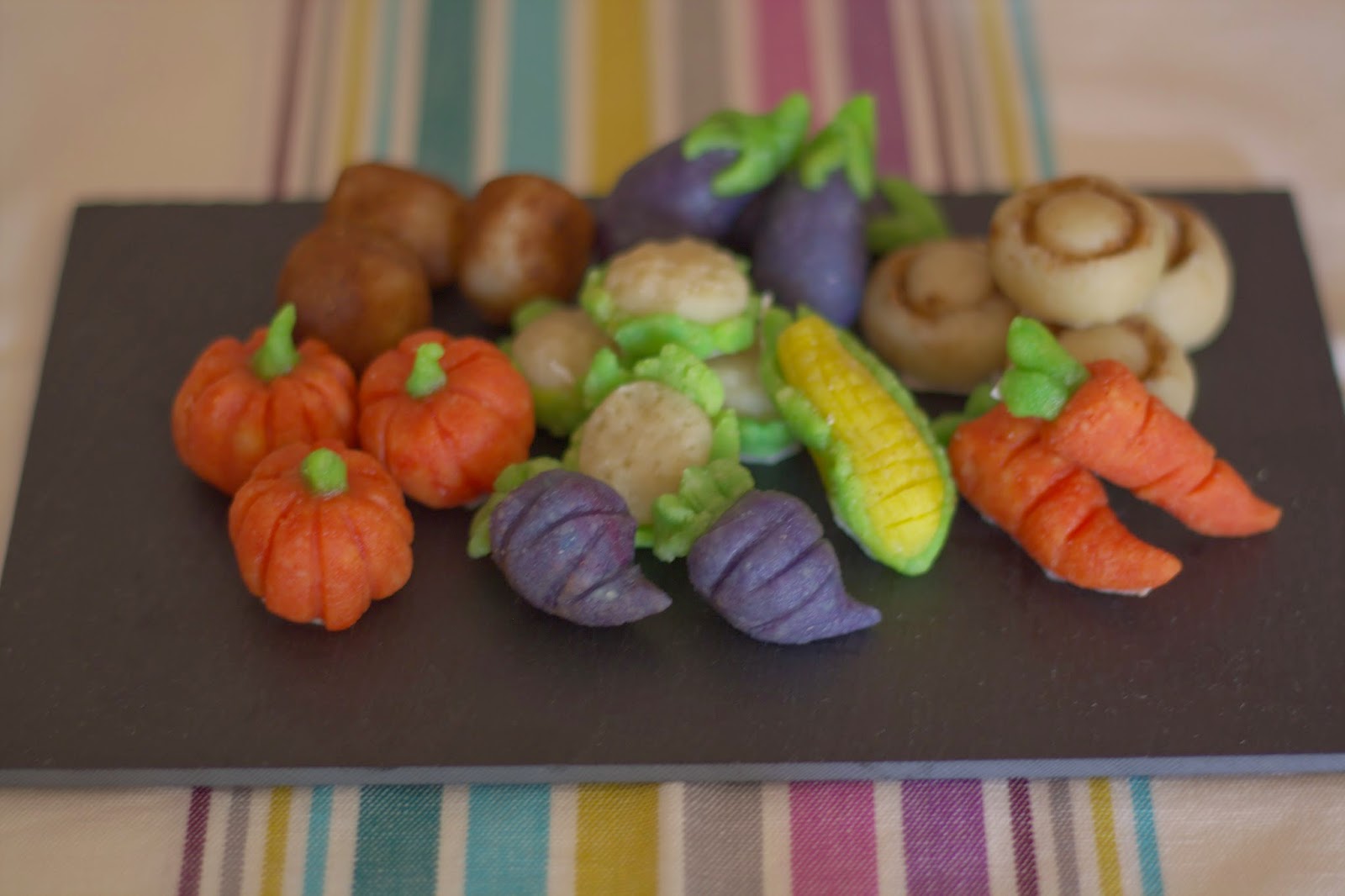
From 1331 this date was established to commemorate the founding of the Kingdom of Valencia, which over time became a celebration of marked festivity in which the worldly pleasures were given free rein.
Unfortunately, with the abolition of the regional code of law by Felipe V in 1707, the celebrations of the 9th of October were also banned. However, all was not lost, and with the intention of the 9th October not losing its festive character, the guild of bakers and confectioners of the city of Valencia impelled the celebration of Saint Dionysius (Sant Donís) as the "day of the lovers".
To this day, the Valencian bakeries prepare themselves thoroughly for the 9th of October and cook thousands of marzipan miniatures; it is estimated that more than 80,000 kilos of marzipan are used to make about 250,000 "mocadoràs". In addition, the Guild of Bakers and Confectioners of Valencia convenes the Sant Donís Contest, to choose the best "mocadorà" and it is the best showcase opportunity for the bakeries and pastry shops throughout the city of Valencia. A frequent winner is El Forn de Latzer. You can see some examples here of their offerings and perhaps pay it a visit if you are in the area :

 3
Like
Published at 8:23 PM Comments (0)
3
Like
Published at 8:23 PM Comments (0)
Tomatina kicks off on 27th August!
Thursday, August 21, 2025
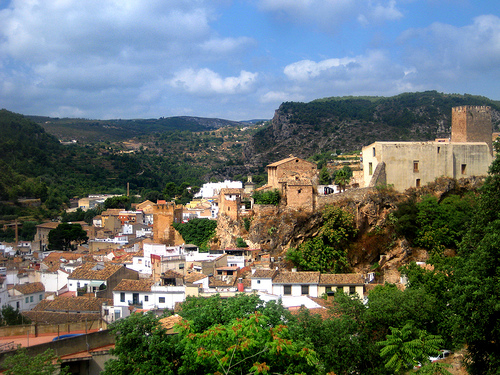 La Tomatina is not far off (27th August) and is one of the Spanish festivities that has still eluded me after so many years and I have it pretty much on my doorstep. Unfortunately, this year will be no different... La Tomatina is not far off (27th August) and is one of the Spanish festivities that has still eluded me after so many years and I have it pretty much on my doorstep. Unfortunately, this year will be no different...
This festivity is relatively recent compared to other Spanish festivities and has become the second most popular festivity outside of Spanish borders and has even been replicated in major cities around the world. Such countries as China, India, Costa Rica, Colombia, the United States, Chile and others all hold their annual tomato battle, so it's not just the Spanish who are a bit crazy, this tomato fever is incredibly contagious. But just how did this unusual festivity come about? I can assure you it has nothing to do with harvests or religious rituals!
It all started on the last Wednesday of August in 1945 when some young people spent the time in the town square attending the “Giants” and “Big-Heads” figures parade, a traditional festivity in the region. The young boys decided they wanted to take part in the parade with musicians, and the locals dressed up as giants.
The exaggerated enthusiasm of these young boys caused one of them to be kicked out of the parade. The participant flew into a fit of rage and started to hit everything in his path and the crowd started to get angry. There was a market stall of vegetables nearby that fell victim to the event and people started to pelt each other with tomatoes until the local forces ended the vegetable battle.
The following year, the young people picked a fight by their own decision but this time brought the tomatoes from home. Although the police broke up the early tradition in the following years, the young boys had made history without being conscious of it. La Tomatina was banned in the early 50s, which was not a problem for the participants, even those that were arrested. But the people spoke out in defence of the Tomatina and the festivity was again allowed with more participants and a more frenetic atmosphere than ever.
The festivity was again cancelled till 1957 when, as a sign of protest, the “tomato burial” was held. It was a demonstration in which the residents carried a coffin with a huge tomato inside. A band that played funeral marches accompanied the parade and it was incredibly successful. La Tomatina Festival was finally allowed and became an official festivity. As a result of the report by Javier Basilio, broadcasted on the Spanish Television Program Informe Semanal, the festivity started to become known in the rest of Spain and consequently the rest of the world, as it is probably one of the most insane festivities you will ever come across.
The actual festivity kicks off at around 10 AM on the last Wednesday of August with the first event of the Tomatina: The "Palo Jabón". This is basically a tall pole that has been smothered in grease. The goal is to climb to the top of the greased pole and recover a Spanish Leg of Ham which is hanging from the top. As this happens, the crowd work into a frenzy of singing and dancing while being showered with water by hoses. Once someone has managed to recover the ham from the pole, the start signal for the tomato fight is given by firing a large water shot in the air and trucks full of tomatoes make their entry.
 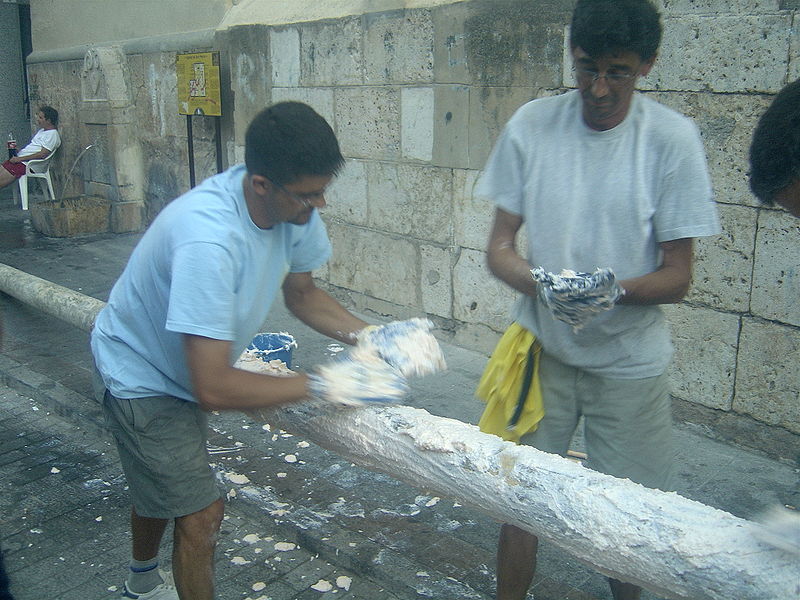
Several trucks empty 1000’s of kilos of tomatoes in the middle of the village Plaza. The tomatoes actually come from Extremadura, where they are much cheaper and are grown specifically for the festivity, being of inferior quality and taste. The tomatoes must be crushed before being thrown so as to reduce the risk of injury and participants are recommended to use of goggles and gloves. The estimated number of tomatoes used are around 150,000kg. After exactly one hour, the fight ends with the firing of the second shot, announcing the end.
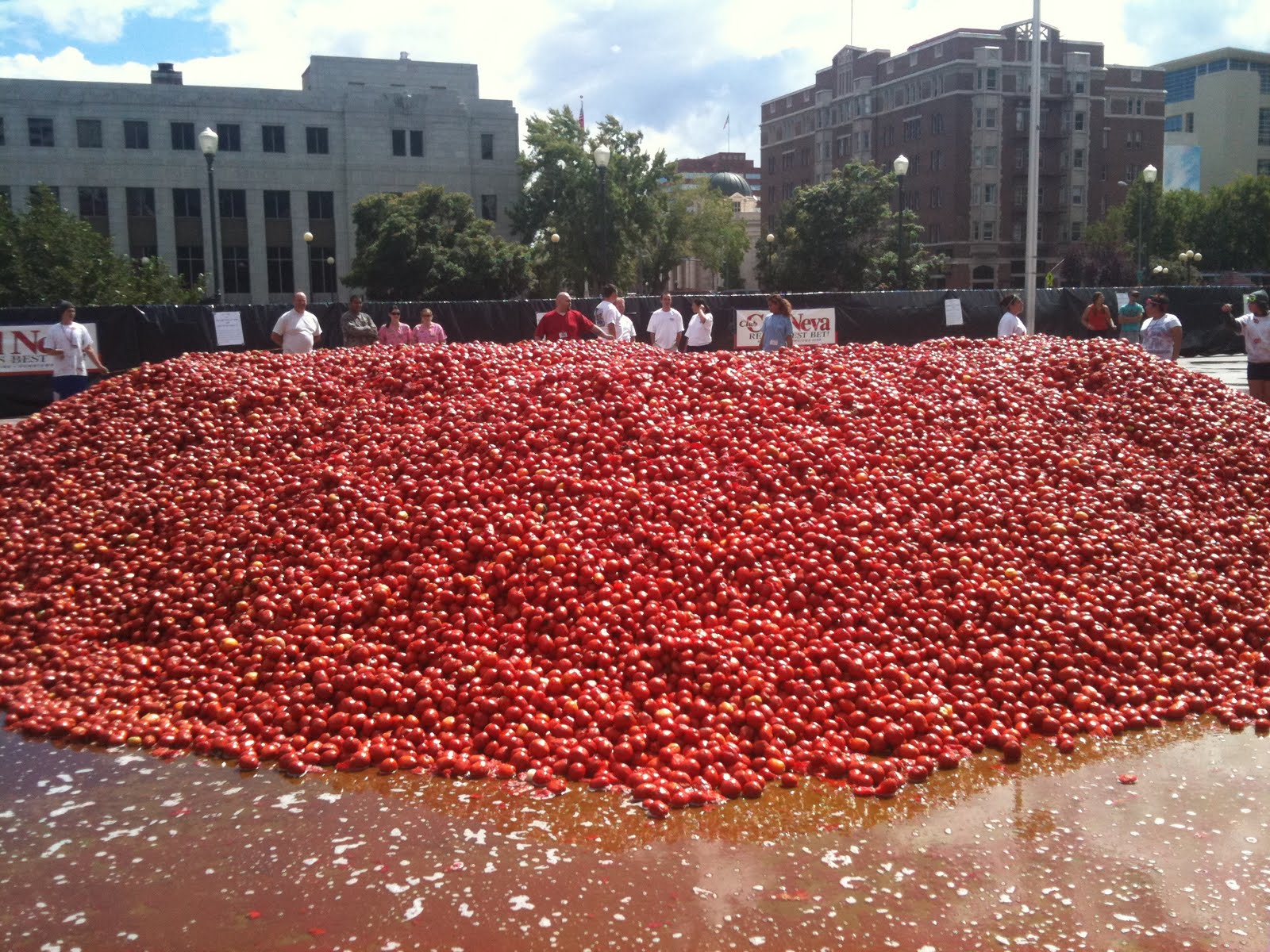
In a question of 60 minutes the whole town square is coloured red and rivers of tomato juice flow deep through the streets. Fire Trucks hose down the streets and participants use hoses that locals provide to remove the tomato paste from their bodies and their front doors!. It is popular for participants go to the pool of “los peñones” to wash off. After the cleaning, the village cobblestone streets are pristine clean due to the acidity of the tomato disinfecting and thoroughly cleaning the surfaces.

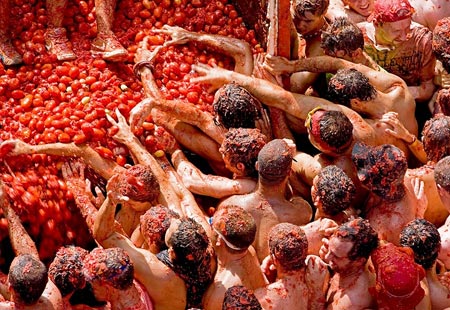

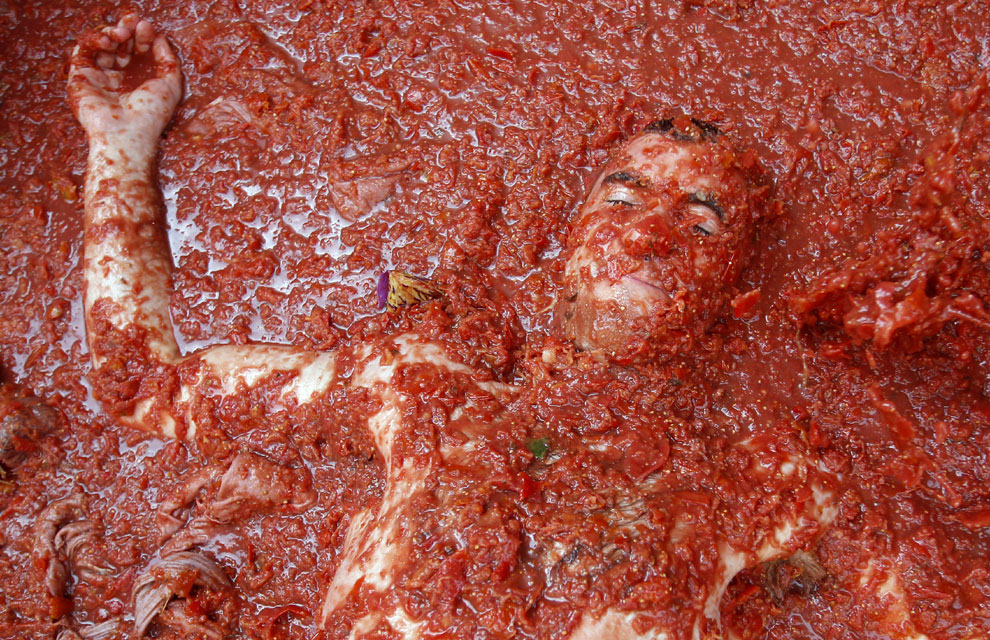
 2
Like
Published at 2:37 PM Comments (1)
2
Like
Published at 2:37 PM Comments (1)
Spam post or Abuse? Please let us know
|
|